

Compact Muon Solenoid
LHC, CERN
| CMS-TOP-18-013 ; CERN-EP-2020-121 | ||
| Measurement of differential $\mathrm{t\bar{t}}$ production cross sections using top quarks at large transverse momenta in pp collisions at $\sqrt{s} = $ 13 TeV | ||
| CMS Collaboration | ||
| 18 August 2020 | ||
| Phys. Rev. D 103 (2021) 052008 | ||
| Abstract: A measurement is reported of differential top quark pair ($\mathrm{t\bar{t}}$) production cross sections, where top quarks are produced at large transverse momenta. The data collected with the CMS detector at the LHC are from pp collisions at a center-of-mass energy of 13 TeV corresponding to an integrated luminosity of 35.9 fb$^{-1}$. The measurement uses events where at least one top quark decays as $\mathrm{t} \to \mathrm{W} \mathrm{b} \to \mathrm{q} \mathrm{\bar{q}}' \mathrm{b}$ and is reconstructed as a large-radius jet with transverse momentum in excess of 400 GeV. The second top quark is required to decay either in a similar way, or leptonically, as inferred from a reconstructed electron or muon, a bottom quark jet, and a missing transverse momentum due to the undetected neutrino. The cross section is extracted as a function of kinematic variables of individual top quarks or of the $\mathrm{t\bar{t}}$ system. The results are presented at the particle level, within a region of phase space close to that of the experimental acceptance, and at the parton level, and are compared to various theoretical models. In both decay channels the observed absolute cross sections are significantly lower than the predictions from theory, while the normalized differential measurements are well described. | ||
| Links: e-print arXiv:2008.07860 [hep-ex] (PDF) ; CDS record ; inSPIRE record ; CADI line (restricted) ; | ||
| Figures | |

png pdf |
Figure 1:
Result of the fit of ${m_{\mathrm {SD}}}$ of the t jet candidate, $m^{\mathrm{t}}$, in the signal region SR$_{\mathrm {A}}$ to data in the all-jet events. The shaded area shows the ${\mathrm{t} {}\mathrm{\bar{t}}}$ contribution, the dashed line the multijet background, and the dash-dotted line the other subdominant backgrounds. The solid line is the fit to the combined signal+background model, and the data points are represented by the filled circles. The lower panel shows the difference between the data and the fit model, divided by the uncertainty in the fit. |

png pdf |
Figure 2:
Comparison between data and prediction in the signal region SR$_{\mathrm {B}}$ (same as the SR, but without an NN requirement) of the NN output distribution for the all-jet channel. The contributions from ${\mathrm{t} {}\mathrm{\bar{t}}}$ and multijet production are normalized according to the fitted values of their respective yields and shown as stacked histograms. The data points are represented by filled circles, while the shaded band represents the statistical uncertainty in simulation. The lower panel shows the data divided by the sum of the predictions. |
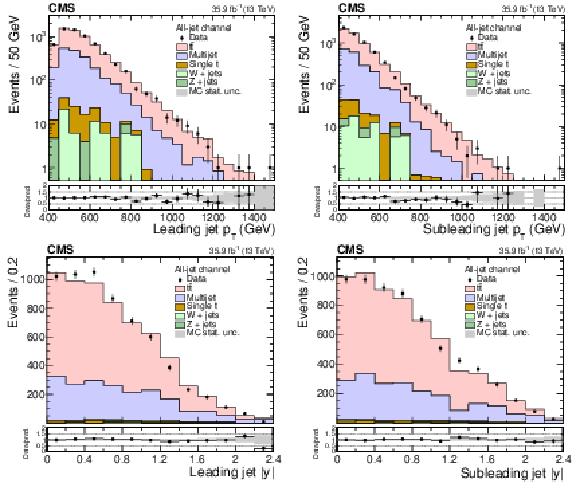
png pdf |
Figure 3:
Comparison between data and prediction in the signal region SR for the ${p_{\mathrm {T}}}$ (upper row) and absolute rapidity (lower row) of the leading (left column) and subleading (right column) large-$R$ jets in the all-jet channel. The contributions from ${\mathrm{t} {}\mathrm{\bar{t}}}$ and multijet production are normalized according to the fitted values of the respective yields and are shown as stacked histograms. The data points are shown with filled circles, while the shaded band represents the statistical uncertainty in the simulation. The lower panel shows the data divided by the sum of the predictions. |

png pdf |
Figure 3-a:
Comparison between data and prediction in the signal region SR for the ${p_{\mathrm {T}}}$ of the leading large-$R$ jet in the all-jet channel. The contributions from ${\mathrm{t} {}\mathrm{\bar{t}}}$ and multijet production are normalized according to the fitted values of the respective yields and are shown as stacked histograms. The data points are shown with filled circles, while the shaded band represents the statistical uncertainty in the simulation. The lower panel shows the data divided by the sum of the predictions. |

png pdf |
Figure 3-b:
Comparison between data and prediction in the signal region SR for the ${p_{\mathrm {T}}}$ of the subleading large-$R$ jet in the all-jet channel. The contributions from ${\mathrm{t} {}\mathrm{\bar{t}}}$ and multijet production are normalized according to the fitted values of the respective yields and are shown as stacked histograms. The data points are shown with filled circles, while the shaded band represents the statistical uncertainty in the simulation. The lower panel shows the data divided by the sum of the predictions. |
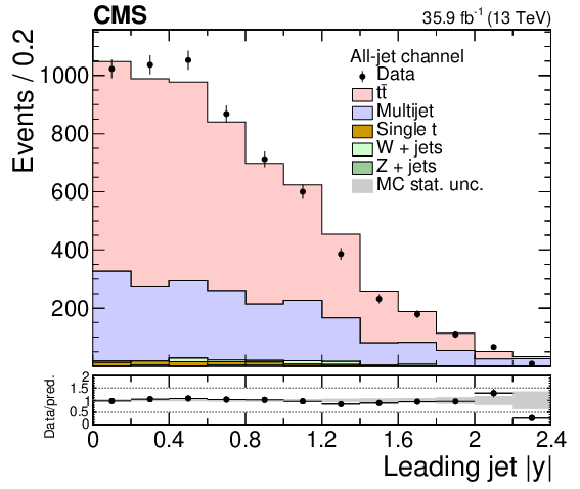
png pdf |
Figure 3-c:
Comparison between data and prediction in the signal region SR for the absolute rapidity of the leading large-$R$ jet in the all-jet channel. The contributions from ${\mathrm{t} {}\mathrm{\bar{t}}}$ and multijet production are normalized according to the fitted values of the respective yields and are shown as stacked histograms. The data points are shown with filled circles, while the shaded band represents the statistical uncertainty in the simulation. The lower panel shows the data divided by the sum of the predictions. |

png pdf |
Figure 3-d:
Comparison between data and prediction in the signal region SR for the absolute rapidity of the subleading large-$R$ jet in the all-jet channel. The contributions from ${\mathrm{t} {}\mathrm{\bar{t}}}$ and multijet production are normalized according to the fitted values of the respective yields and are shown as stacked histograms. The data points are shown with filled circles, while the shaded band represents the statistical uncertainty in the simulation. The lower panel shows the data divided by the sum of the predictions. |

png pdf |
Figure 4:
Comparison between data and prediction in the signal region SR of the all-jet channel for the kinematic properties of the system of the two leading large-$R$ jets (${\mathrm{t} {}\mathrm{\bar{t}}}$ candidates). Specifically, the invariant mass (upper left), ${p_{\mathrm {T}}}$ (upper right), and rapidity (lower). The contributions from ${\mathrm{t} {}\mathrm{\bar{t}}}$ and multijet production are normalized according to the fitted values of the respective yields and are shown as stacked histograms. The data points are shown with filled circles, while the shaded band represents the statistical uncertainty in the simulation. The lower panel shows the data divided by the sum of the predictions. |

png pdf |
Figure 4-a:
Comparison between data and prediction in the signal region SR of the all-jet channel for the invariant mass of the system of the two leading large-$R$ jets (${\mathrm{t} {}\mathrm{\bar{t}}}$ candidates). The contributions from ${\mathrm{t} {}\mathrm{\bar{t}}}$ and multijet production are normalized according to the fitted values of the respective yields and are shown as stacked histograms. The data points are shown with filled circles, while the shaded band represents the statistical uncertainty in the simulation. The lower panel shows the data divided by the sum of the predictions. |
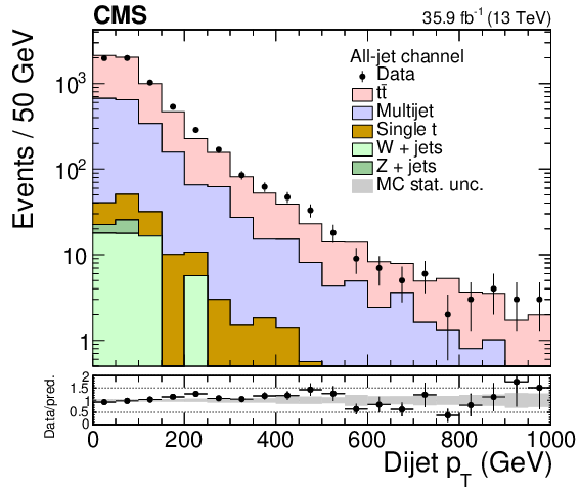
png pdf |
Figure 4-b:
Comparison between data and prediction in the signal region SR of the all-jet channel for the ${p_{\mathrm {T}}}$ of the system of the two leading large-$R$ jets (${\mathrm{t} {}\mathrm{\bar{t}}}$ candidates). The contributions from ${\mathrm{t} {}\mathrm{\bar{t}}}$ and multijet production are normalized according to the fitted values of the respective yields and are shown as stacked histograms. The data points are shown with filled circles, while the shaded band represents the statistical uncertainty in the simulation. The lower panel shows the data divided by the sum of the predictions. |

png pdf |
Figure 4-c:
Comparison between data and prediction in the signal region SR of the all-jet channel for the rapidity of the system of the two leading large-$R$ jets (${\mathrm{t} {}\mathrm{\bar{t}}}$ candidates). The contributions from ${\mathrm{t} {}\mathrm{\bar{t}}}$ and multijet production are normalized according to the fitted values of the respective yields and are shown as stacked histograms. The data points are shown with filled circles, while the shaded band represents the statistical uncertainty in the simulation. The lower panel shows the data divided by the sum of the predictions. |

png pdf |
Figure 5:
Comparison between data and prediction in the signal region SR for the mass of the leading (left) and subleading (right) large-$R$ jets in the all-jet channel. The ${\mathrm{t} {}\mathrm{\bar{t}}}$ and multijet production are normalized according to the fitted values of the respective yields and are displayed as stacked histograms. The data points are shown with filled circles, while the shaded band represents the statistical uncertainty in the simulation. The lower panel shows the data divided by the sum of the predictions. |
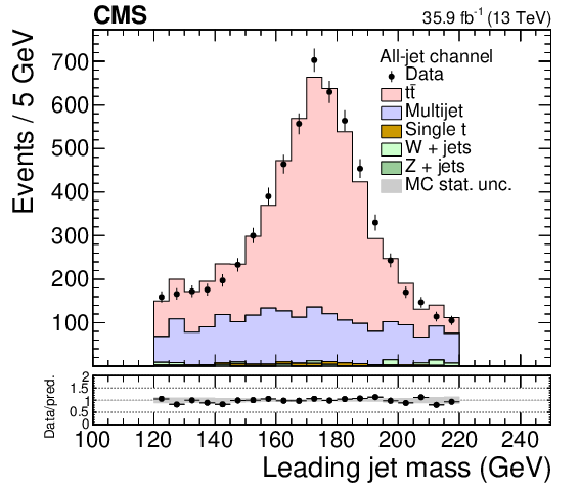
png pdf |
Figure 5-a:
Comparison between data and prediction in the signal region SR for the mass of the leading large-$R$ jets in the all-jet channel. The ${\mathrm{t} {}\mathrm{\bar{t}}}$ and multijet production are normalized according to the fitted values of the respective yields and are displayed as stacked histograms. The data points are shown with filled circles, while the shaded band represents the statistical uncertainty in the simulation. The lower panel shows the data divided by the sum of the predictions. |

png pdf |
Figure 5-b:
Comparison between data and prediction in the signal region SR for the mass of the subleading large-$R$ jets in the all-jet channel. The ${\mathrm{t} {}\mathrm{\bar{t}}}$ and multijet production are normalized according to the fitted values of the respective yields and are displayed as stacked histograms. The data points are shown with filled circles, while the shaded band represents the statistical uncertainty in the simulation. The lower panel shows the data divided by the sum of the predictions. |
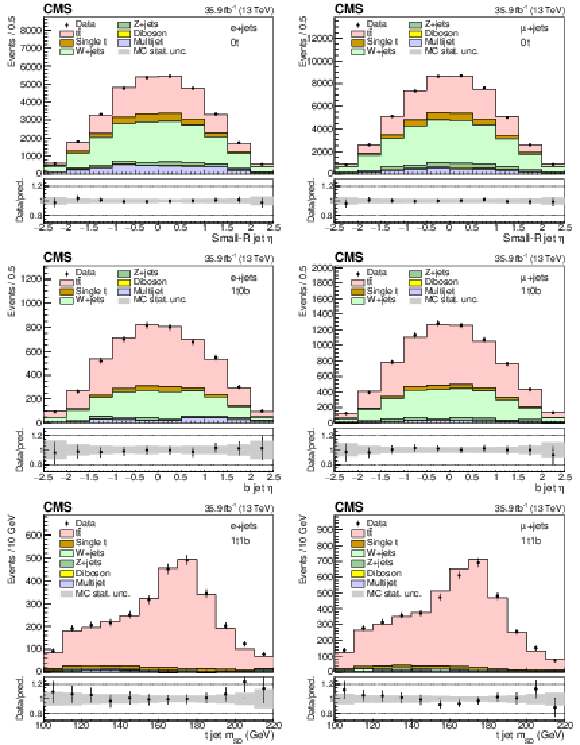
png pdf |
Figure 6:
Posterior kinematic distributions in the maximum-likelihood fit. Different event categories and variables are fitted: $\eta $ distribution for small-$R$ jets in 0t events (upper row), $\eta $ distribution of the b jet candidate in 1t0b events (middle row), and ${m_{\mathrm {SD}}}$ of the t jet candidate in 1t1b events (lower row), in the e+jets (left column) and $\mu $+jets (right column) channels. The data points are indicated by filled circles, while the signal and background predictions are shown as stacked histograms. The lower panels show data divided by the sum of the predictions and their systematic uncertainties as obtained from the fit (shaded band). |
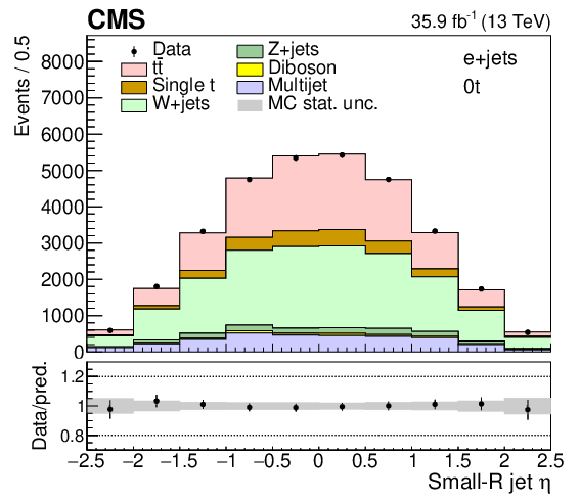
png pdf |
Figure 6-a:
Posterior kinematic distribution in the maximum-likelihood fit of $\eta $ for small-$R$ jets in 0t events in the e+jets channel. The data points are indicated by filled circles, while the signal and background predictions are shown as stacked histograms. The lower panel shows data divided by the sum of the predictions and their systematic uncertainties as obtained from the fit (shaded band). |
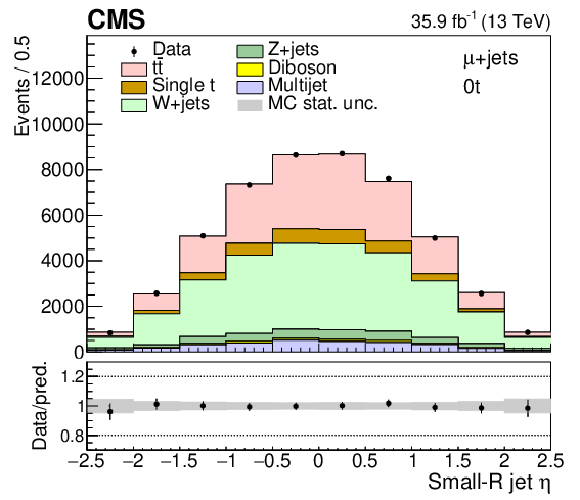
png pdf |
Figure 6-b:
Posterior kinematic distribution in the maximum-likelihood fit of $\eta $ for small-$R$ jets in 0t events in the $\mu $+jets channel. The data points are indicated by filled circles, while the signal and background predictions are shown as stacked histograms. The lower panel shows data divided by the sum of the predictions and their systematic uncertainties as obtained from the fit (shaded band). |

png pdf |
Figure 6-c:
Posterior kinematic distribution in the maximum-likelihood fit of the $\eta $ of the b jet candidate in 1t0b events in the e+jets channel. The data points are indicated by filled circles, while the signal and background predictions are shown as stacked histograms. The lower panel shows data divided by the sum of the predictions and their systematic uncertainties as obtained from the fit (shaded band). |

png pdf |
Figure 6-d:
Posterior kinematic distribution in the maximum-likelihood fit of the $\eta $ of the b jet candidate in 1t0b events in the $\mu$+jets channel. The data points are indicated by filled circles, while the signal and background predictions are shown as stacked histograms. The lower panel shows data divided by the sum of the predictions and their systematic uncertainties as obtained from the fit (shaded band). |

png pdf |
Figure 6-e:
Posterior kinematic distribution in the maximum-likelihood fit of the ${m_{\mathrm {SD}}}$ of the t jet candidate in 1t1b events in the e+jets channel. The data points are indicated by filled circles, while the signal and background predictions are shown as stacked histograms. The lower panel shows data divided by the sum of the predictions and their systematic uncertainties as obtained from the fit (shaded band). |

png pdf |
Figure 6-f:
Posterior kinematic distribution in the maximum-likelihood fit of the ${m_{\mathrm {SD}}}$ of the t jet candidate in 1t1b events in the $\mu $+jets channel. The data points are indicated by filled circles, while the signal and background predictions are shown as stacked histograms. The lower panel shows data divided by the sum of the predictions and their systematic uncertainties as obtained from the fit (shaded band). |

png pdf |
Figure 7:
Distributions of the ${p_{\mathrm {T}}}$ (left column) and $y$ (right column) of the t jet candidate for the 0t (upper row), 1t0b (middle row), and 1t1b (lower row) events in the combined $\ell $+jets channel that use the posterior t tag scale factors and background normalizations. The data points are given by the filled circles, while the signal and background predictions are shown as stacked histograms. The lower panels show data divided by the sum of the predictions and their systematic uncertainties as obtained from the fit (shaded band). |

png pdf |
Figure 7-a:
Distribution of the ${p_{\mathrm {T}}}$ of the t jet candidate for the 0t events in the combined $\ell $+jets channel that use the posterior t tag scale factors and background normalizations. The data points are given by the filled circles, while the signal and background predictions are shown as stacked histograms. The lower panel shows data divided by the sum of the predictions and their systematic uncertainties as obtained from the fit (shaded band). |

png pdf |
Figure 7-b:
Distribution of the $y$ of the t jet candidate for the 0t events in the combined $\ell $+jets channel that use the posterior t tag scale factors and background normalizations. The data points are given by the filled circles, while the signal and background predictions are shown as stacked histograms. The lower panel shows data divided by the sum of the predictions and their systematic uncertainties as obtained from the fit (shaded band). |
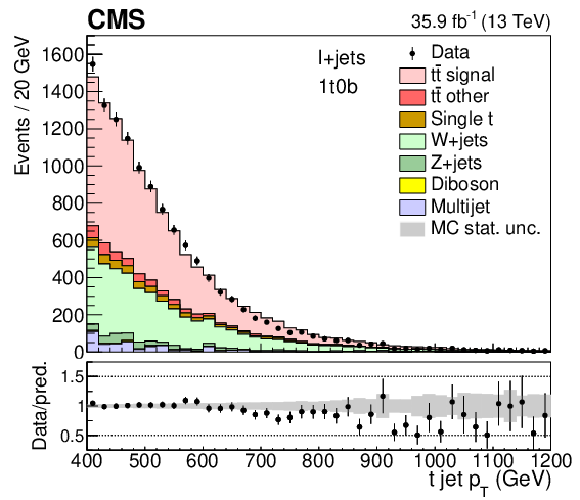
png pdf |
Figure 7-c:
Distribution of the ${p_{\mathrm {T}}}$ of the t jet candidate for the 1t0b events in the combined $\ell $+jets channel that use the posterior t tag scale factors and background normalizations. The data points are given by the filled circles, while the signal and background predictions are shown as stacked histograms. The lower panel shows data divided by the sum of the predictions and their systematic uncertainties as obtained from the fit (shaded band). |

png pdf |
Figure 7-d:
Distribution of the $y$ of the t jet candidate for the 1t0b events in the combined $\ell $+jets channel that use the posterior t tag scale factors and background normalizations. The data points are given by the filled circles, while the signal and background predictions are shown as stacked histograms. The lower panel shows data divided by the sum of the predictions and their systematic uncertainties as obtained from the fit (shaded band). |
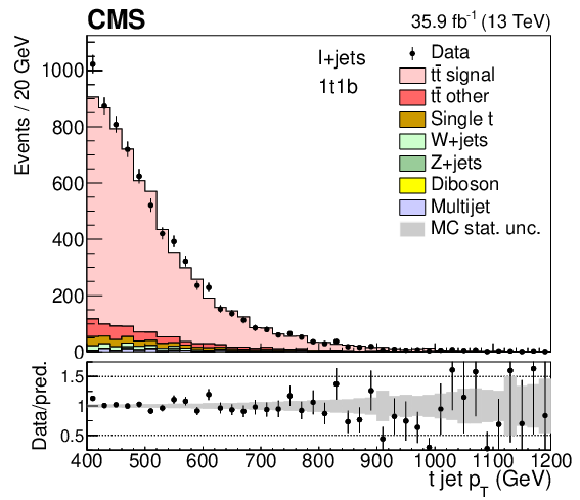
png pdf |
Figure 7-e:
Distribution of the ${p_{\mathrm {T}}}$ of the t jet candidate for the 1t1b events in the combined $\ell $+jets channel that use the posterior t tag scale factors and background normalizations. The data points are given by the filled circles, while the signal and background predictions are shown as stacked histograms. The lower panel shows data divided by the sum of the predictions and their systematic uncertainties as obtained from the fit (shaded band). |
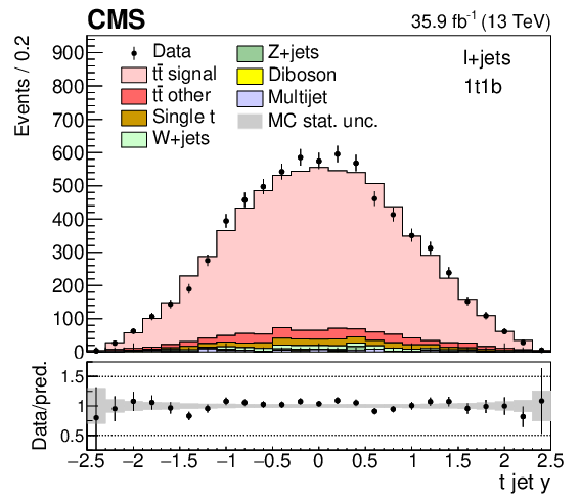
png pdf |
Figure 7-f:
Distribution of the $y$ of the t jet candidate for the 1t1b events in the combined $\ell $+jets channel that use the posterior t tag scale factors and background normalizations. The data points are given by the filled circles, while the signal and background predictions are shown as stacked histograms. The lower panel shows data divided by the sum of the predictions and their systematic uncertainties as obtained from the fit (shaded band). |

png pdf |
Figure 8:
Simulated fractions $f_1$ and $f_2$ for the parton-level (upper row) and particle-level (lower row) selection in the all-jet channel as a function of the leading top quark ${p_{\mathrm {T}}}$ (left column) and $ {| y |}$ (right column). The fraction $f_1$ is a function of the leading reconstructed top quark and the $f_2$ is a function of the leading top quark at parton or particle level. |
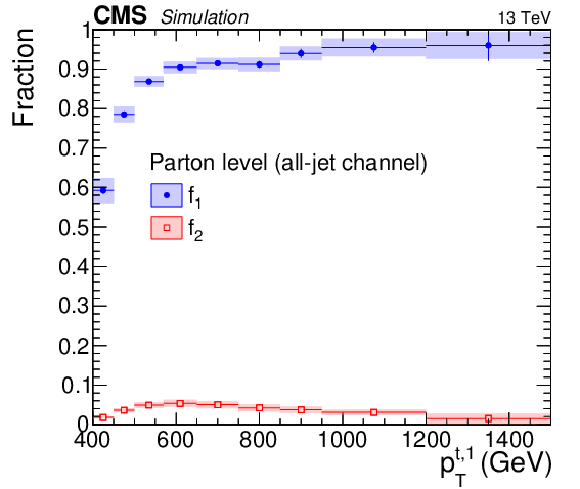
png pdf |
Figure 8-a:
Simulated fractions $f_1$ and $f_2$ for the parton-level selection in the all-jet channel as a function of the leading top quark ${p_{\mathrm {T}}}$. The fraction $f_1$ is a function of the leading reconstructed top quark and the $f_2$ is a function of the leading top quark at parton or particle level. |
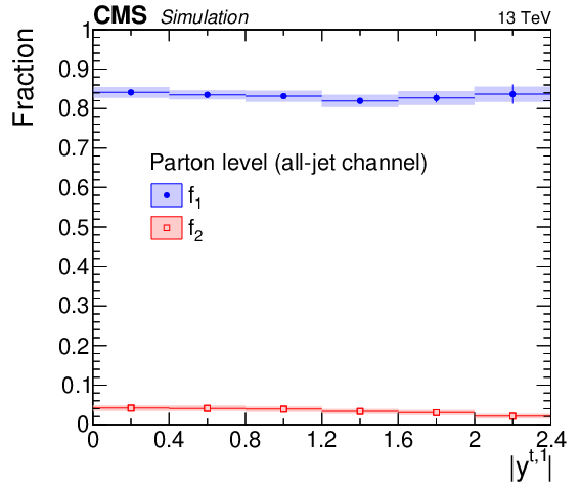
png pdf |
Figure 8-b:
Simulated fractions $f_1$ and $f_2$ for the parton-level selection in the all-jet channel as a function of the leading top quark $ {| y |}$. The fraction $f_1$ is a function of the leading reconstructed top quark and the $f_2$ is a function of the leading top quark at parton or particle level. |
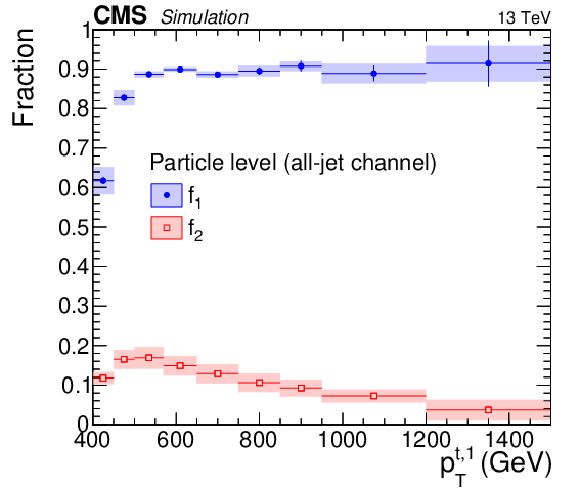
png pdf |
Figure 8-c:
Simulated fractions $f_1$ and $f_2$ for the particle-level selection in the all-jet channel as a function of the leading top quark ${p_{\mathrm {T}}}$. The fraction $f_1$ is a function of the leading reconstructed top quark and the $f_2$ is a function of the leading top quark at parton or particle level. |
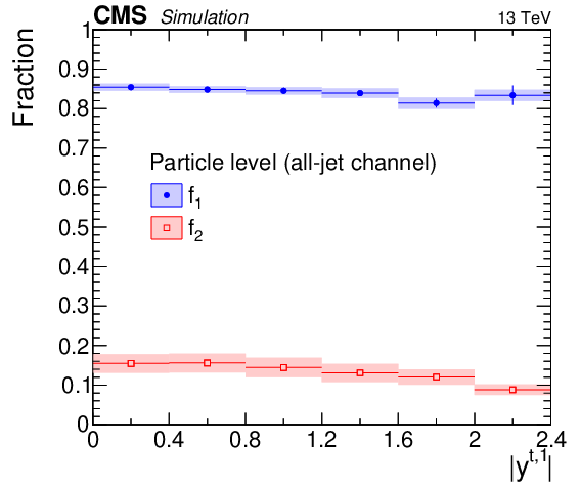
png pdf |
Figure 8-d:
Simulated fractions $f_1$ and $f_2$ for the particle-level selection in the all-jet channel as a function of the leading top quark $ {| y |}$. The fraction $f_1$ is a function of the leading reconstructed top quark and the $f_2$ is a function of the leading top quark at parton or particle level. |

png pdf |
Figure 9:
Migration matrices determined from simulation for the leading top quark ${p_{\mathrm {T}}}$ (upper row) and $m^{{\mathrm{t} {}\mathrm{\bar{t}}}}$ (lower row) at the parton level (left) and particle level (right) in the all-jet channel. Each column is normalized to unity. |

png pdf |
Figure 9-a:
Migration matrices determined from simulation for the leading top quark ${p_{\mathrm {T}}}$ at the parton level in the all-jet channel. Each column is normalized to unity. |

png pdf |
Figure 9-b:
Migration matrices determined from simulation for the leading top quark ${p_{\mathrm {T}}}$ at the particle level in the all-jet channel. Each column is normalized to unity. |

png pdf |
Figure 9-c:
Migration matrices determined from simulation for the leading top quark $m^{{\mathrm{t} {}\mathrm{\bar{t}}}}$ at the parton level in the all-jet channel. Each column is normalized to unity. |
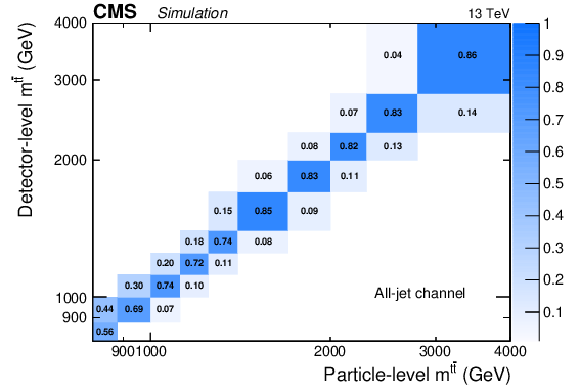
png pdf |
Figure 9-d:
Migration matrices determined from simulation for the leading top quark $m^{{\mathrm{t} {}\mathrm{\bar{t}}}}$ at the particle level in the all-jet channel. Each column is normalized to unity. |
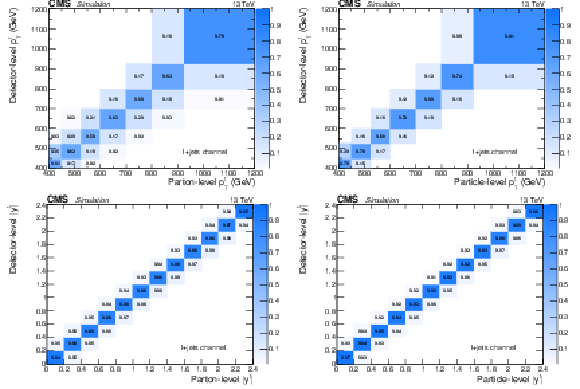
png pdf |
Figure 10:
Migration matrices determined from simulation for top quark ${p_{\mathrm {T}}}$ (upper row) and rapidity (lower row) at the parton level (left) and particle level (right) in the $\ell $+jets channel. Each column is normalized to unity. |
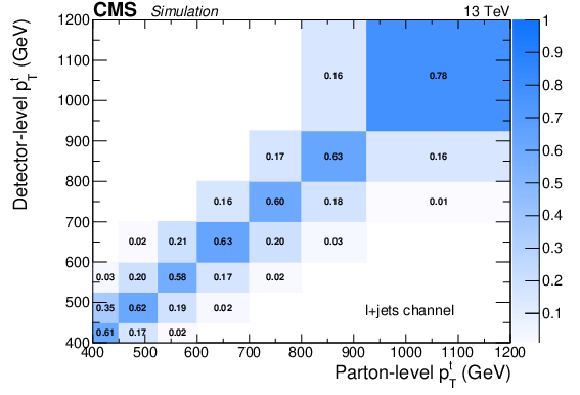
png pdf |
Figure 10-a:
Migration matrices determined from simulation for top quark ${p_{\mathrm {T}}}$ at the parton level in the $\ell $+jets channel. Each column is normalized to unity. |

png pdf |
Figure 10-b:
Migration matrices determined from simulation for top quark ${p_{\mathrm {T}}}$ at the particle level in the $\ell $+jets channel. Each column is normalized to unity. |

png pdf |
Figure 10-c:
Migration matrices determined from simulation for top quark rapidity at the parton level in the $\ell $+jets channel. Each column is normalized to unity. |
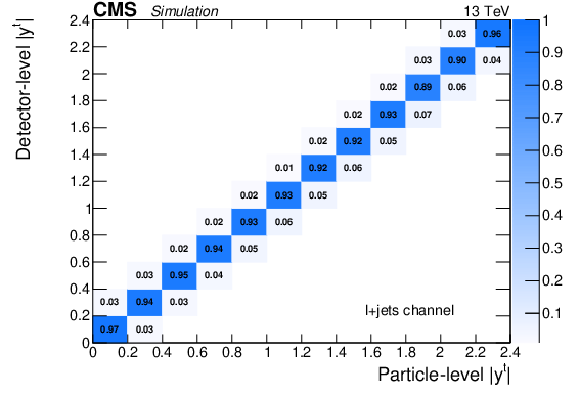
png pdf |
Figure 10-d:
Migration matrices determined from simulation for top quark rapidity at the particle level in the $\ell $+jets channel. Each column is normalized to unity. |

png pdf |
Figure 11:
Differential cross section unfolded to the particle level, absolute (left) and normalized (right), as a function of the leading (upper row) and subleading (lower row) top quark ${p_{\mathrm {T}}}$ in the all-jet channel. The lower panel shows the ratio (MC/data)$-$1. The vertical bars on the data and in the ratio represent the statistical uncertainty in data, while the shaded band shows the total statistical and systematic uncertainty added in quadrature. |
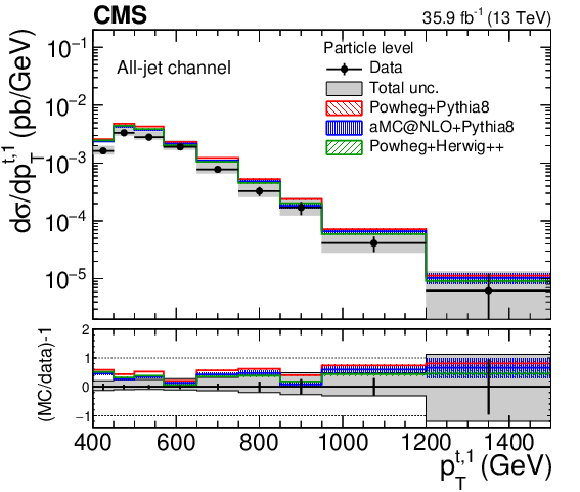
png pdf |
Figure 11-a:
Differential cross section unfolded to the particle level, absolute, as a function of the leading top quark ${p_{\mathrm {T}}}$ in the all-jet channel. The lower panel shows the ratio (MC/data)$-$1. The vertical bars on the data and in the ratio represent the statistical uncertainty in data, while the shaded band shows the total statistical and systematic uncertainty added in quadrature. |

png pdf |
Figure 11-b:
Differential cross section unfolded to the particle level, normalized, as a function of the leading top quark ${p_{\mathrm {T}}}$ in the all-jet channel. The lower panel shows the ratio (MC/data)$-$1. The vertical bars on the data and in the ratio represent the statistical uncertainty in data, while the shaded band shows the total statistical and systematic uncertainty added in quadrature. |
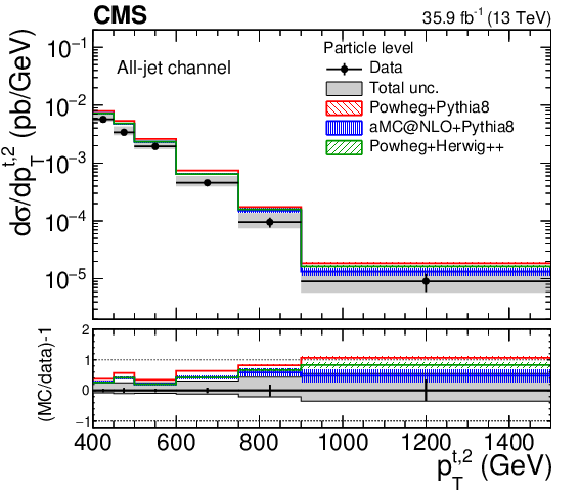
png pdf |
Figure 11-c:
Differential cross section unfolded to the particle level, absolute, as a function of the subleading top quark ${p_{\mathrm {T}}}$ in the all-jet channel. The lower panel shows the ratio (MC/data)$-$1. The vertical bars on the data and in the ratio represent the statistical uncertainty in data, while the shaded band shows the total statistical and systematic uncertainty added in quadrature. |

png pdf |
Figure 11-d:
Differential cross section unfolded to the particle level, normalized, as a function of the subleading top quark ${p_{\mathrm {T}}}$ in the all-jet channel. The lower panel shows the ratio (MC/data)$-$1. The vertical bars on the data and in the ratio represent the statistical uncertainty in data, while the shaded band shows the total statistical and systematic uncertainty added in quadrature. |

png pdf |
Figure 12:
Differential cross section unfolded to the particle level, absolute (left) and normalized (right), as a function of the leading (upper row) and subleading (lower row) top quark $ {| y |}$ in the all-jet channel. The lower panel shows the ratio (MC/data)$-$1. The vertical bars on the data and in the ratio represent the statistical uncertainty in data, while the shaded band shows the total statistical and systematic uncertainty added in quadrature. |

png pdf |
Figure 12-a:
Differential cross section unfolded to the particle level, absolute, as a function of the leading top quark $ {| y |}$ in the all-jet channel. The lower panel shows the ratio (MC/data)$-$1. The vertical bars on the data and in the ratio represent the statistical uncertainty in data, while the shaded band shows the total statistical and systematic uncertainty added in quadrature. |
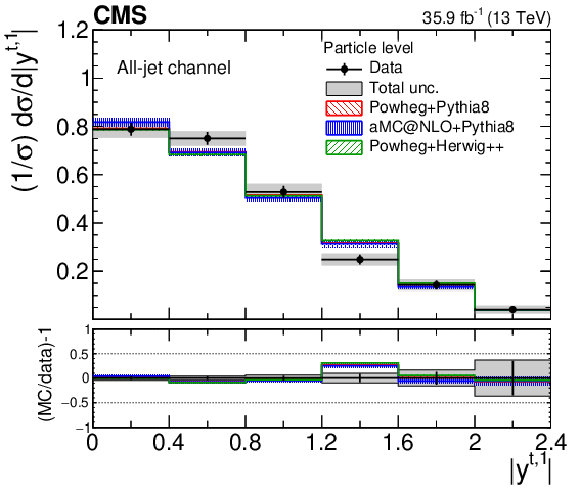
png pdf |
Figure 12-b:
Differential cross section unfolded to the particle level, normalized, as a function of the leading top quark $ {| y |}$ in the all-jet channel. The lower panel shows the ratio (MC/data)$-$1. The vertical bars on the data and in the ratio represent the statistical uncertainty in data, while the shaded band shows the total statistical and systematic uncertainty added in quadrature. |

png pdf |
Figure 12-c:
Differential cross section unfolded to the particle level, absolute, as a function of the subleading top quark $ {| y |}$ in the all-jet channel. The lower panel shows the ratio (MC/data)$-$1. The vertical bars on the data and in the ratio represent the statistical uncertainty in data, while the shaded band shows the total statistical and systematic uncertainty added in quadrature. |
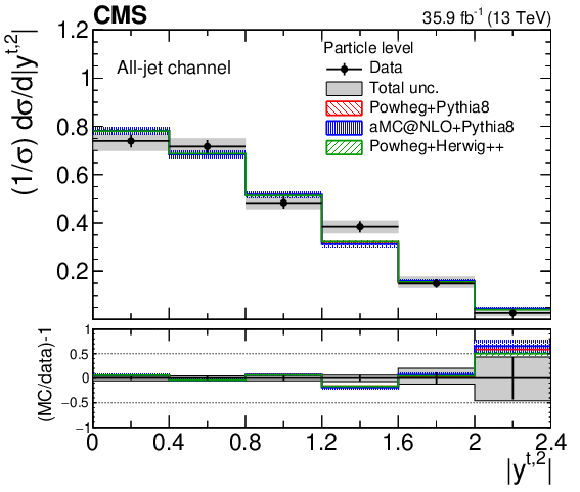
png pdf |
Figure 12-d:
Differential cross section unfolded to the particle level, normalized, as a function of the subleading top quark $ {| y |}$ in the all-jet channel. The lower panel shows the ratio (MC/data)$-$1. The vertical bars on the data and in the ratio represent the statistical uncertainty in data, while the shaded band shows the total statistical and systematic uncertainty added in quadrature. |
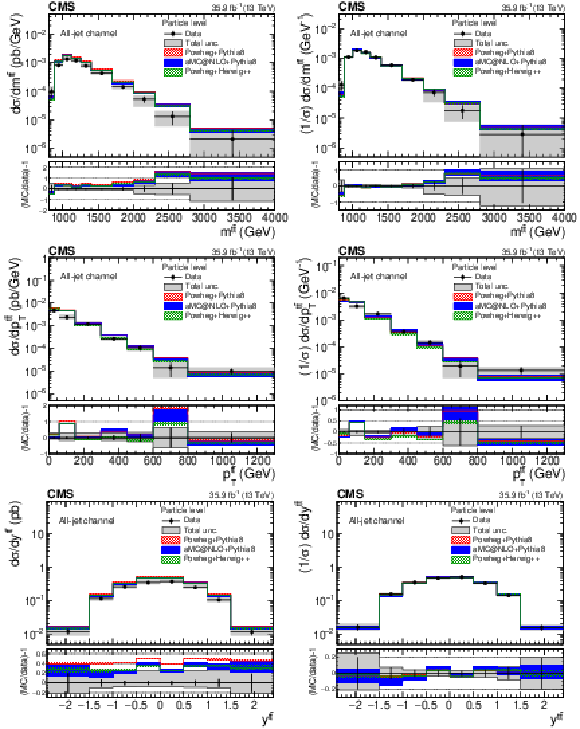
png pdf |
Figure 13:
Differential cross section unfolded to the particle level, absolute (left) and normalized (right), as a function of $m^{{\mathrm{t} {}\mathrm{\bar{t}}}}$ (upper row), $ {p_{\mathrm {T}}} ^{{\mathrm{t} {}\mathrm{\bar{t}}}}$ (middle row), and $y^{{\mathrm{t} {}\mathrm{\bar{t}}}}$ (lower row) in the all-jet channel. The lower panel shows the ratio (MC/data)$-$1. The vertical bars on the data and in the ratio represent the statistical uncertainty in data, while the shaded band shows the total statistical and systematic uncertainty added in quadrature. |
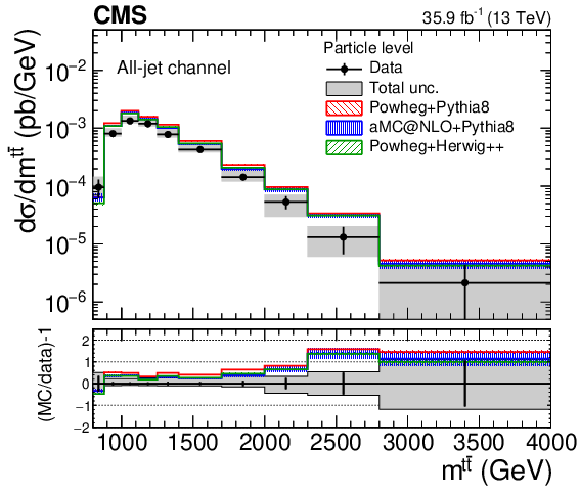
png pdf |
Figure 13-a:
Differential cross section unfolded to the particle level, absolute, as a function of $m^{{\mathrm{t} {}\mathrm{\bar{t}}}}$ in the all-jet channel. The lower panel shows the ratio (MC/data)$-$1. The vertical bars on the data and in the ratio represent the statistical uncertainty in data, while the shaded band shows the total statistical and systematic uncertainty added in quadrature. |
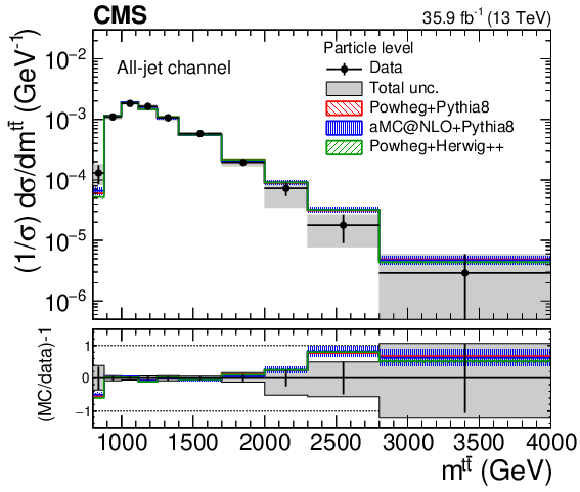
png pdf |
Figure 13-b:
Differential cross section unfolded to the particle level, normalized, as a function of $m^{{\mathrm{t} {}\mathrm{\bar{t}}}}$ n the all-jet channel. The lower panel shows the ratio (MC/data)$-$1. The vertical bars on the data and in the ratio represent the statistical uncertainty in data, while the shaded band shows the total statistical and systematic uncertainty added in quadrature. |
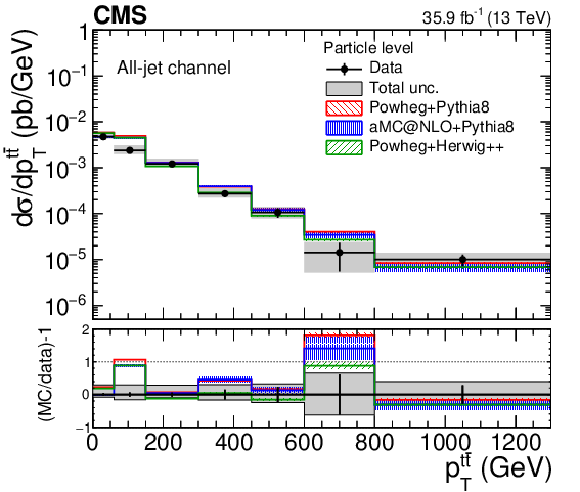
png pdf |
Figure 13-c:
Differential cross section unfolded to the particle level, absolute, as a function of $ {p_{\mathrm {T}}} ^{{\mathrm{t} {}\mathrm{\bar{t}}}}$ in the all-jet channel. The lower panel shows the ratio (MC/data)$-$1. The vertical bars on the data and in the ratio represent the statistical uncertainty in data, while the shaded band shows the total statistical and systematic uncertainty added in quadrature. |
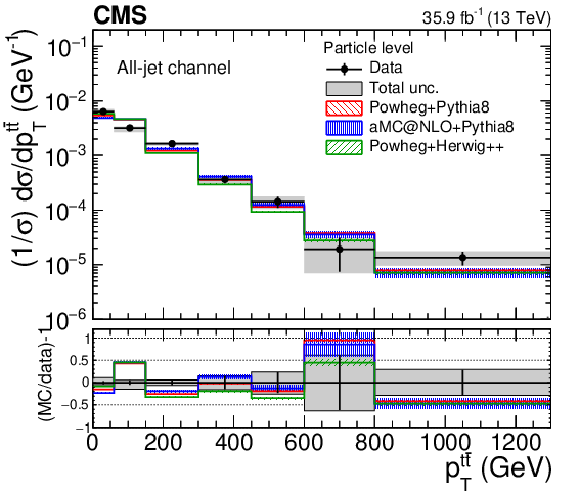
png pdf |
Figure 13-d:
Differential cross section unfolded to the particle level, normalized, as a function of $ {p_{\mathrm {T}}} ^{{\mathrm{t} {}\mathrm{\bar{t}}}}$ in the all-jet channel. The lower panel shows the ratio (MC/data)$-$1. The vertical bars on the data and in the ratio represent the statistical uncertainty in data, while the shaded band shows the total statistical and systematic uncertainty added in quadrature. |

png pdf |
Figure 13-e:
Differential cross section unfolded to the particle level, absolute, as a function of $y^{{\mathrm{t} {}\mathrm{\bar{t}}}}$ in the all-jet channel. The lower panel shows the ratio (MC/data)$-$1. The vertical bars on the data and in the ratio represent the statistical uncertainty in data, while the shaded band shows the total statistical and systematic uncertainty added in quadrature. |
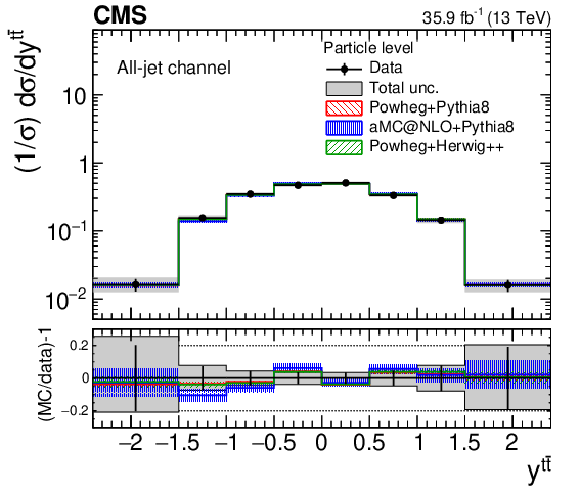
png pdf |
Figure 13-f:
Differential cross section unfolded to the particle level, normalized, as a function of $y^{{\mathrm{t} {}\mathrm{\bar{t}}}}$ in the all-jet channel. The lower panel shows the ratio (MC/data)$-$1. The vertical bars on the data and in the ratio represent the statistical uncertainty in data, while the shaded band shows the total statistical and systematic uncertainty added in quadrature. |

png pdf |
Figure 14:
Differential cross section unfolded to the parton level, absolute (left) and normalized (right), as a function of the leading (upper row) and subleading (lower row) top quark ${p_{\mathrm {T}}}$ in the all-jet channel. The lower panel shows the ratio (MC/data)$-$1. The vertical bars on the data and in the ratio represent the statistical uncertainty in data, while the shaded band shows the total statistical and systematic uncertainty added in quadrature. |
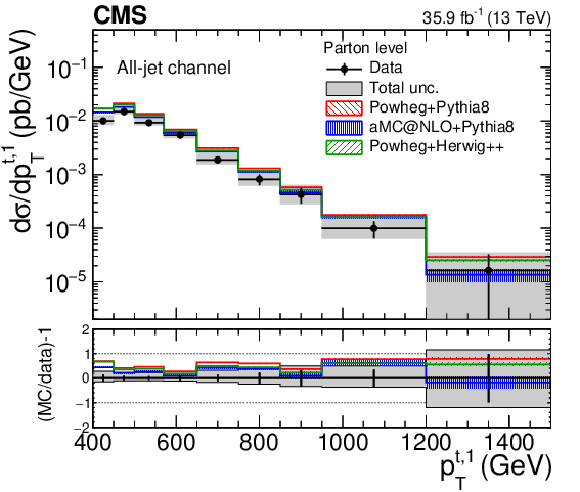
png pdf |
Figure 14-a:
Differential cross section unfolded to the parton level, absolute, as a function of the leading top quark ${p_{\mathrm {T}}}$ in the all-jet channel. The lower panel shows the ratio (MC/data)$-$1. The vertical bars on the data and in the ratio represent the statistical uncertainty in data, while the shaded band shows the total statistical and systematic uncertainty added in quadrature. |

png pdf |
Figure 14-b:
Differential cross section unfolded to the parton level, normalized, as a function of the leading top quark ${p_{\mathrm {T}}}$ in the all-jet channel. The lower panel shows the ratio (MC/data)$-$1. The vertical bars on the data and in the ratio represent the statistical uncertainty in data, while the shaded band shows the total statistical and systematic uncertainty added in quadrature. |
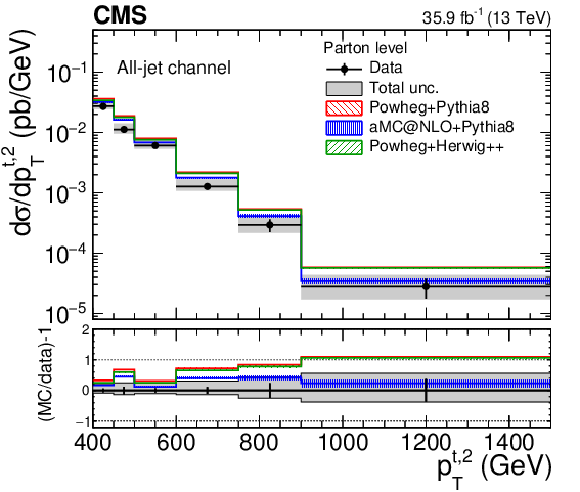
png pdf |
Figure 14-c:
Differential cross section unfolded to the parton level, absolute, as a function of the subleading top quark ${p_{\mathrm {T}}}$ in the all-jet channel. The lower panel shows the ratio (MC/data)$-$1. The vertical bars on the data and in the ratio represent the statistical uncertainty in data, while the shaded band shows the total statistical and systematic uncertainty added in quadrature. |

png pdf |
Figure 14-d:
Differential cross section unfolded to the parton level, normalized, as a function of the subleading top quark ${p_{\mathrm {T}}}$ in the all-jet channel. The lower panel shows the ratio (MC/data)$-$1. The vertical bars on the data and in the ratio represent the statistical uncertainty in data, while the shaded band shows the total statistical and systematic uncertainty added in quadrature. |

png pdf |
Figure 15:
Differential cross section unfolded to the parton level, absolute (left) and normalized (right), as a function of the leading (upper row) and subleading (lower row) top quark $ {| y |}$ in the all-jet channel. The lower panel shows the ratio (MC/data)$-$1. The vertical bars on the data and in the ratio represent the statistical uncertainty in data, while the shaded band shows the total statistical and systematic uncertainty added in quadrature. |
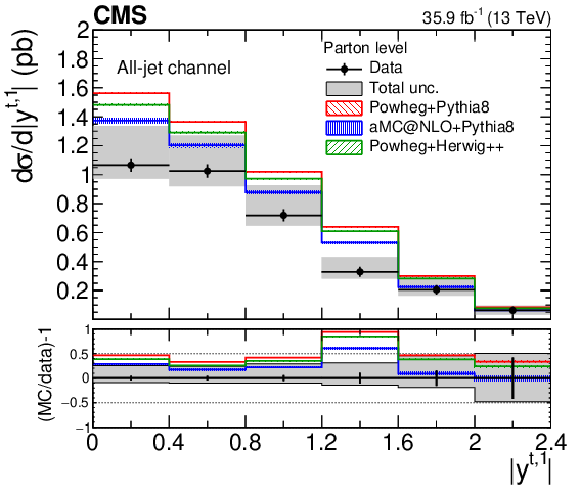
png pdf |
Figure 15-a:
Differential cross section unfolded to the parton level, absolute, as a function of the leading top quark $ {| y |}$ in the all-jet channel. The lower panel shows the ratio (MC/data)$-$1. The vertical bars on the data and in the ratio represent the statistical uncertainty in data, while the shaded band shows the total statistical and systematic uncertainty added in quadrature. |

png pdf |
Figure 15-b:
Differential cross section unfolded to the parton level, normalized, as a function of the leading top quark $ {| y |}$ in the all-jet channel. The lower panel shows the ratio (MC/data)$-$1. The vertical bars on the data and in the ratio represent the statistical uncertainty in data, while the shaded band shows the total statistical and systematic uncertainty added in quadrature. |

png pdf |
Figure 15-c:
Differential cross section unfolded to the parton level, absolute, as a function of the subleading top quark $ {| y |}$ in the all-jet channel. The lower panel shows the ratio (MC/data)$-$1. The vertical bars on the data and in the ratio represent the statistical uncertainty in data, while the shaded band shows the total statistical and systematic uncertainty added in quadrature. |

png pdf |
Figure 15-d:
Differential cross section unfolded to the parton level, normalized, as a function of the subleading top quark $ {| y |}$ in the all-jet channel. The lower panel shows the ratio (MC/data)$-$1. The vertical bars on the data and in the ratio represent the statistical uncertainty in data, while the shaded band shows the total statistical and systematic uncertainty added in quadrature. |

png pdf |
Figure 16:
Differential cross section unfolded to the parton level, absolute (left) and normalized (right), as a function of $m^{{\mathrm{t} {}\mathrm{\bar{t}}}}$ (upper row), $ {p_{\mathrm {T}}} ^{{\mathrm{t} {}\mathrm{\bar{t}}}}$ (middle row), and $y^{{\mathrm{t} {}\mathrm{\bar{t}}}}$ (lower row) in the all-jet channel. The lower panel shows the ratio (MC/data)$-$1. The vertical bars on the data and in the ratio represent the statistical uncertainty in data, while the shaded band shows the total statistical and systematic uncertainty added in quadrature. |

png pdf |
Figure 16-a:
Differential cross section unfolded to the parton level, absolute, as a function of $m^{{\mathrm{t} {}\mathrm{\bar{t}}}}$ in the all-jet channel. The lower panel shows the ratio (MC/data)$-$1. The vertical bars on the data and in the ratio represent the statistical uncertainty in data, while the shaded band shows the total statistical and systematic uncertainty added in quadrature. |
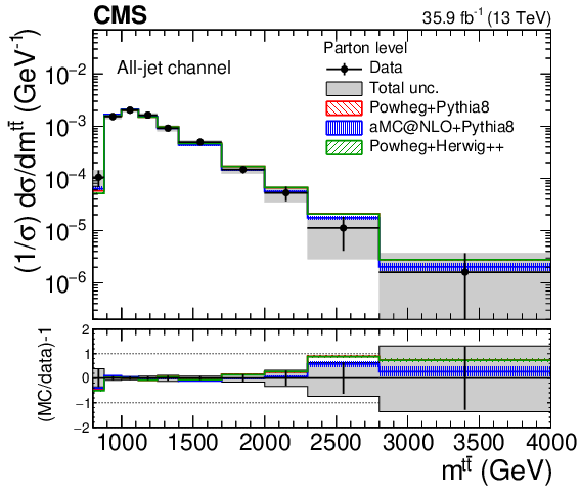
png pdf |
Figure 16-b:
Differential cross section unfolded to the parton level, normalized, as a function of $m^{{\mathrm{t} {}\mathrm{\bar{t}}}}$ in the all-jet channel. The lower panel shows the ratio (MC/data)$-$1. The vertical bars on the data and in the ratio represent the statistical uncertainty in data, while the shaded band shows the total statistical and systematic uncertainty added in quadrature. |
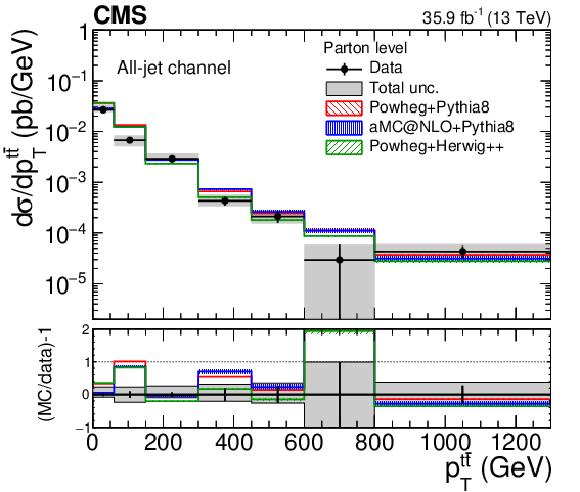
png pdf |
Figure 16-c:
Differential cross section unfolded to the parton level, absolute, as a function of $ {p_{\mathrm {T}}} ^{{\mathrm{t} {}\mathrm{\bar{t}}}}$ in the all-jet channel. The lower panel shows the ratio (MC/data)$-$1. The vertical bars on the data and in the ratio represent the statistical uncertainty in data, while the shaded band shows the total statistical and systematic uncertainty added in quadrature. |
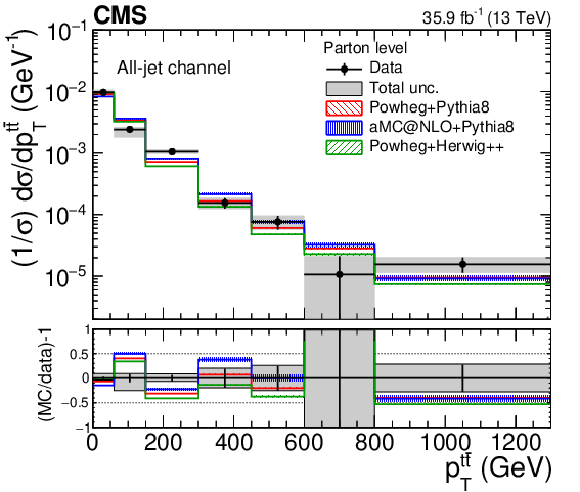
png pdf |
Figure 16-d:
Differential cross section unfolded to the parton level, normalized, as a function of $ {p_{\mathrm {T}}} ^{{\mathrm{t} {}\mathrm{\bar{t}}}}$ in the all-jet channel. The lower panel shows the ratio (MC/data)$-$1. The vertical bars on the data and in the ratio represent the statistical uncertainty in data, while the shaded band shows the total statistical and systematic uncertainty added in quadrature. |

png pdf |
Figure 16-e:
Differential cross section unfolded to the parton level, absolute, as a function of $y^{{\mathrm{t} {}\mathrm{\bar{t}}}}$ in the all-jet channel. The lower panel shows the ratio (MC/data)$-$1. The vertical bars on the data and in the ratio represent the statistical uncertainty in data, while the shaded band shows the total statistical and systematic uncertainty added in quadrature. |

png pdf |
Figure 16-f:
Differential cross section unfolded to the parton level, normalized, as a function of $y^{{\mathrm{t} {}\mathrm{\bar{t}}}}$ in the all-jet channel. The lower panel shows the ratio (MC/data)$-$1. The vertical bars on the data and in the ratio represent the statistical uncertainty in data, while the shaded band shows the total statistical and systematic uncertainty added in quadrature. |
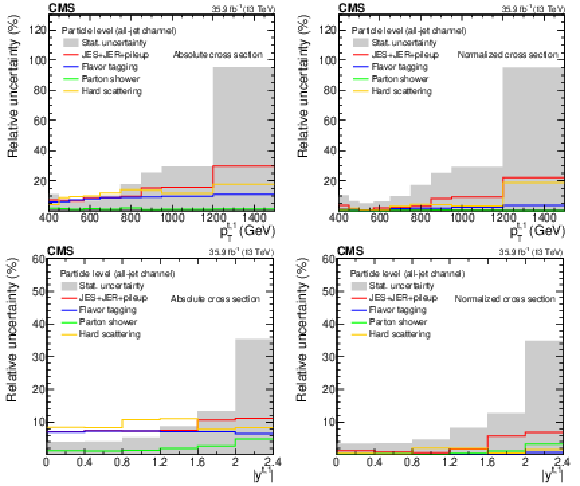
png pdf |
Figure 17:
Breakdown of the uncertainties in the absolute (left column) and normalized (right column) measurement at the particle level, as a function of the leading top quark ${p_{\mathrm {T}}}$ (upper row) and $ {| y |}$ (lower row) in the all-jet channel. The shaded band shows the statistical uncertainty, while the solid lines show the systematic uncertainties grouped in four categories: a) uncertainty due to pileup and the JES and JER of the large-$R$ jets, b) uncertainty due to flavor tagging of the subjets, c) uncertainty due to the modeling of the parton shower, and d) uncertainty due to the modeling of the hard scattering. |

png pdf |
Figure 17-a:
Breakdown of the uncertainties in the absolute measurement at the particle level, as a function of the leading top quark ${p_{\mathrm {T}}}$ in the all-jet channel. The shaded band shows the statistical uncertainty, while the solid lines show the systematic uncertainties grouped in four categories: a) uncertainty due to pileup and the JES and JER of the large-$R$ jets, b) uncertainty due to flavor tagging of the subjets, c) uncertainty due to the modeling of the parton shower, and d) uncertainty due to the modeling of the hard scattering. |
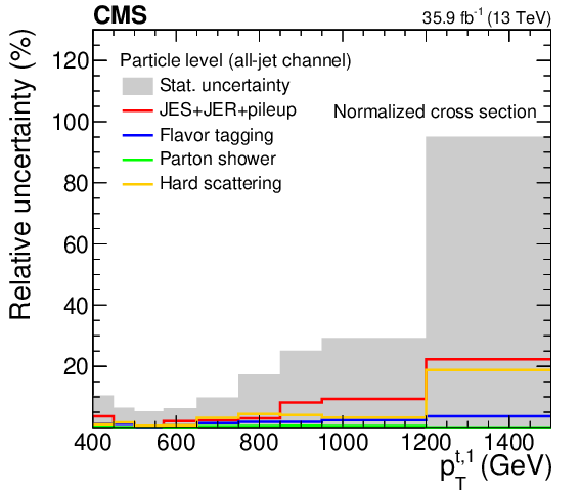
png pdf |
Figure 17-b:
Breakdown of the uncertainties in the normalized measurement at the particle level, as a function of the leading top quark ${p_{\mathrm {T}}}$ in the all-jet channel. The shaded band shows the statistical uncertainty, while the solid lines show the systematic uncertainties grouped in four categories: a) uncertainty due to pileup and the JES and JER of the large-$R$ jets, b) uncertainty due to flavor tagging of the subjets, c) uncertainty due to the modeling of the parton shower, and d) uncertainty due to the modeling of the hard scattering. |

png pdf |
Figure 17-c:
Breakdown of the uncertainties in the absolute measurement at the particle level, as a function of the leading top quark $ {| y |}$ in the all-jet channel. The shaded band shows the statistical uncertainty, while the solid lines show the systematic uncertainties grouped in four categories: a) uncertainty due to pileup and the JES and JER of the large-$R$ jets, b) uncertainty due to flavor tagging of the subjets, c) uncertainty due to the modeling of the parton shower, and d) uncertainty due to the modeling of the hard scattering. |

png pdf |
Figure 17-d:
Breakdown of the uncertainties in the normalized measurement at the particle level, as a function of the leading top quark $ {| y |}$ in the all-jet channel. The shaded band shows the statistical uncertainty, while the solid lines show the systematic uncertainties grouped in four categories: a) uncertainty due to pileup and the JES and JER of the large-$R$ jets, b) uncertainty due to flavor tagging of the subjets, c) uncertainty due to the modeling of the parton shower, and d) uncertainty due to the modeling of the hard scattering. |

png pdf |
Figure 18:
Breakdown of the uncertainties in the absolute (left column) and normalized (right column) measurement at the parton level, as a function of the leading top quark ${p_{\mathrm {T}}}$ (upper row) and $ {| y |}$ (lower row) in the all-jet channel. The shaded band shows the statistical uncertainty, while the solid lines show the systematic uncertainties grouped in four categories: a) uncertainty due to pileup and the JES and JER of the large-$R$ jets, b) uncertainty due to flavor tagging of the subjets, c) uncertainty due to the modeling of the parton shower, and d) uncertainty due to the modeling of the hard scattering. |

png pdf |
Figure 18-a:
Breakdown of the uncertainties in the absolute measurement at the parton level, as a function of the leading top quark ${p_{\mathrm {T}}}$ in the all-jet channel. The shaded band shows the statistical uncertainty, while the solid lines show the systematic uncertainties grouped in four categories: a) uncertainty due to pileup and the JES and JER of the large-$R$ jets, b) uncertainty due to flavor tagging of the subjets, c) uncertainty due to the modeling of the parton shower, and d) uncertainty due to the modeling of the hard scattering. |

png pdf |
Figure 18-b:
Breakdown of the uncertainties in the normalized measurement at the parton level, as a function of the leading top quark ${p_{\mathrm {T}}}$ in the all-jet channel. The shaded band shows the statistical uncertainty, while the solid lines show the systematic uncertainties grouped in four categories: a) uncertainty due to pileup and the JES and JER of the large-$R$ jets, b) uncertainty due to flavor tagging of the subjets, c) uncertainty due to the modeling of the parton shower, and d) uncertainty due to the modeling of the hard scattering. |

png pdf |
Figure 18-c:
Breakdown of the uncertainties in the absolute measurement at the parton level, as a function of the leading top quark $ {| y |}$ in the all-jet channel. The shaded band shows the statistical uncertainty, while the solid lines show the systematic uncertainties grouped in four categories: a) uncertainty due to pileup and the JES and JER of the large-$R$ jets, b) uncertainty due to flavor tagging of the subjets, c) uncertainty due to the modeling of the parton shower, and d) uncertainty due to the modeling of the hard scattering. |

png pdf |
Figure 18-d:
Breakdown of the uncertainties in the normalized measurement at the parton level, as a function of the leading top quark $ {| y |}$ in the all-jet channel. The shaded band shows the statistical uncertainty, while the solid lines show the systematic uncertainties grouped in four categories: a) uncertainty due to pileup and the JES and JER of the large-$R$ jets, b) uncertainty due to flavor tagging of the subjets, c) uncertainty due to the modeling of the parton shower, and d) uncertainty due to the modeling of the hard scattering. |
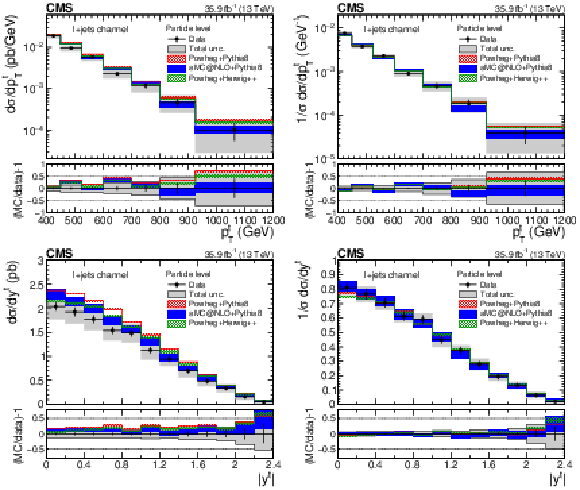
png pdf |
Figure 19:
Differential cross section measurements at the particle level, as a function of the particle-level t jet ${p_{\mathrm {T}}}$ (upper row) and $ {| y |}$ (lower row) for the $\ell $+jets channel. Both absolute (left column) and normalized (right column) cross sections are shown. The lower panel shows the ratio (MC/data)$-$1. The vertical bars on the data and in the ratio represent the statistical uncertainty in data, while the shaded band shows the total statistical and systematic uncertainty added in quadrature. |

png pdf |
Figure 19-a:
Differential cross section measurements at the particle level, as a function of the particle-level t jet ${p_{\mathrm {T}}}$ for the $\ell $+jets channel. The absolute cross section is shown. The lower panel shows the ratio (MC/data)$-$1. The vertical bars on the data and in the ratio represent the statistical uncertainty in data, while the shaded band shows the total statistical and systematic uncertainty added in quadrature. |

png pdf |
Figure 19-b:
Differential cross section measurements at the particle level, as a function of the particle-level t jet ${p_{\mathrm {T}}}$ for the $\ell $+jets channel. The normalized cross section is shown. The lower panel shows the ratio (MC/data)$-$1. The vertical bars on the data and in the ratio represent the statistical uncertainty in data, while the shaded band shows the total statistical and systematic uncertainty added in quadrature. |

png pdf |
Figure 19-c:
Differential cross section measurements at the particle level, as a function of the particle-level t jet $ {| y |}$ for the $\ell $+jets channel. The absolute cross section is shown. The lower panel shows the ratio (MC/data)$-$1. The vertical bars on the data and in the ratio represent the statistical uncertainty in data, while the shaded band shows the total statistical and systematic uncertainty added in quadrature. |
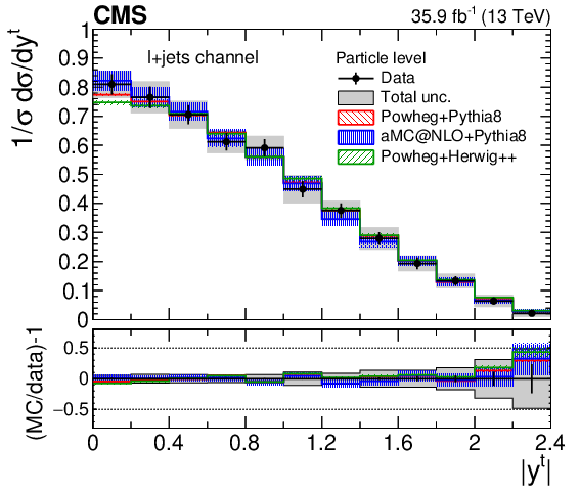
png pdf |
Figure 19-d:
Differential cross section measurements at the particle level, as a function of the particle-level t jet $ {| y |}$ for the $\ell $+jets channel. The normalized cross section is shown. The lower panel shows the ratio (MC/data)$-$1. The vertical bars on the data and in the ratio represent the statistical uncertainty in data, while the shaded band shows the total statistical and systematic uncertainty added in quadrature. |
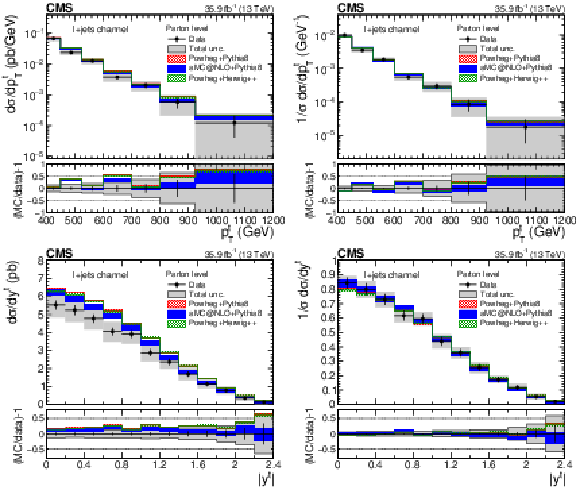
png pdf |
Figure 20:
Differential cross section measurements at the parton level, as a function of the parton-level top quark ${p_{\mathrm {T}}}$ (upper row) and $ {| y |}$ (lower row) for the $\ell $+jets channel. Both absolute (left column) and normalized (right column) cross sections are shown. The lower panel shows the ratio (MC/data)$-$1. The vertical bars on the data and in the ratio represent the statistical uncertainty in data, while the shaded band shows the total statistical and systematic uncertainty added in quadrature. |

png pdf |
Figure 20-a:
Differential cross section measurements at the parton level, as a function of the parton-level top quark ${p_{\mathrm {T}}}$ for the $\ell $+jets channel. The absolute cross section is shown. The lower panel shows the ratio (MC/data)$-$1. The vertical bars on the data and in the ratio represent the statistical uncertainty in data, while the shaded band shows the total statistical and systematic uncertainty added in quadrature. |

png pdf |
Figure 20-b:
Differential cross section measurements at the parton level, as a function of the parton-level top quark ${p_{\mathrm {T}}}$ for the $\ell $+jets channel. The normalized cross section is shown. The lower panel shows the ratio (MC/data)$-$1. The vertical bars on the data and in the ratio represent the statistical uncertainty in data, while the shaded band shows the total statistical and systematic uncertainty added in quadrature. |

png pdf |
Figure 20-c:
Differential cross section measurements at the parton level, as a function of the parton-level top quark $ {| y |}$ for the $\ell $+jets channel. The absolute cross section is shown. The lower panel shows the ratio (MC/data)$-$1. The vertical bars on the data and in the ratio represent the statistical uncertainty in data, while the shaded band shows the total statistical and systematic uncertainty added in quadrature. |
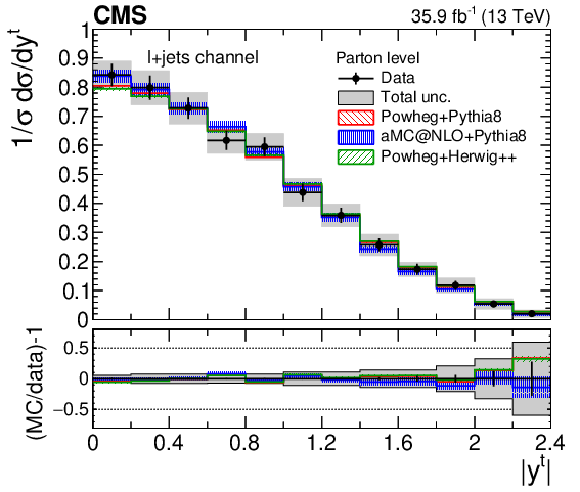
png pdf |
Figure 20-d:
Differential cross section measurements at the parton level, as a function of the parton-level top quark $ {| y |}$ for the $\ell $+jets channel. The normalized cross section is shown. The lower panel shows the ratio (MC/data)$-$1. The vertical bars on the data and in the ratio represent the statistical uncertainty in data, while the shaded band shows the total statistical and systematic uncertainty added in quadrature. |
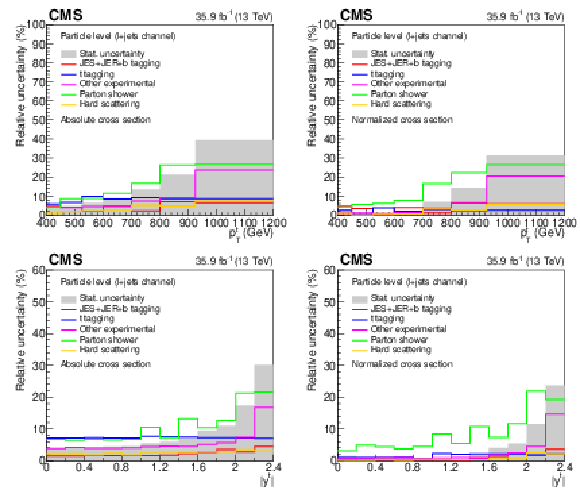
png pdf |
Figure 21:
Breakdown of the sources of systematic uncertainty affecting the differential cross section measurements in the $\ell $+jets channel at the particle level as a function of the particle-level t jet ${p_{\mathrm {T}}}$ (upper row) or $ {| y |}$ (lower row). Both the systematic uncertainties in the absolute (left column) and the normalized (right column) cross sections are shown. "JES+JER+b tagging" includes uncertainties due to the JES, JER, and small-$R$ jet b tagging efficiency; "t tagging" is the uncertainty associated with the large-$R$ jet t tagging efficiency; "Other experimental" includes the uncertainties originating from the background estimate, pileup modeling, lepton identification and trigger efficiency, and measurement of the integrated luminosity; "Parton shower" includes contributions from ISR and FSR, underlying event tune, ME-PS matching, and color reconnection; "Hard scattering" includes the uncertainty due to PDFs, as well as renormalization and factorization scales. The grey bands shows the statistical uncertainty. |

png pdf |
Figure 21-a:
Breakdown of the sources of systematic uncertainty affecting the differential cross section measurements in the $\ell $+jets channel at the particle level as a function of the particle-level t jet ${p_{\mathrm {T}}}$. Systematic uncertainties in the absolute cross section is shown. "JES+JER+b tagging" includes uncertainties due to the JES, JER, and small-$R$ jet b tagging efficiency; "t tagging" is the uncertainty associated with the large-$R$ jet t tagging efficiency; "Other experimental" includes the uncertainties originating from the background estimate, pileup modeling, lepton identification and trigger efficiency, and measurement of the integrated luminosity; "Parton shower" includes contributions from ISR and FSR, underlying event tune, ME-PS matching, and color reconnection; "Hard scattering" includes the uncertainty due to PDFs, as well as renormalization and factorization scales. The grey bands shows the statistical uncertainty. |

png pdf |
Figure 21-b:
Breakdown of the sources of systematic uncertainty affecting the differential cross section measurements in the $\ell $+jets channel at the particle level as a function of the particle-level t jet ${p_{\mathrm {T}}}$. Systematic uncertainties in the normalized cross section is shown. "JES+JER+b tagging" includes uncertainties due to the JES, JER, and small-$R$ jet b tagging efficiency; "t tagging" is the uncertainty associated with the large-$R$ jet t tagging efficiency; "Other experimental" includes the uncertainties originating from the background estimate, pileup modeling, lepton identification and trigger efficiency, and measurement of the integrated luminosity; "Parton shower" includes contributions from ISR and FSR, underlying event tune, ME-PS matching, and color reconnection; "Hard scattering" includes the uncertainty due to PDFs, as well as renormalization and factorization scales. The grey bands shows the statistical uncertainty. |

png pdf |
Figure 21-c:
Breakdown of the sources of systematic uncertainty affecting the differential cross section measurements in the $\ell $+jets channel at the particle level as a function of the particle-level t jet $ {| y |}$. Systematic uncertainties in the absolute cross section is shown. "JES+JER+b tagging" includes uncertainties due to the JES, JER, and small-$R$ jet b tagging efficiency; "t tagging" is the uncertainty associated with the large-$R$ jet t tagging efficiency; "Other experimental" includes the uncertainties originating from the background estimate, pileup modeling, lepton identification and trigger efficiency, and measurement of the integrated luminosity; "Parton shower" includes contributions from ISR and FSR, underlying event tune, ME-PS matching, and color reconnection; "Hard scattering" includes the uncertainty due to PDFs, as well as renormalization and factorization scales. The grey bands shows the statistical uncertainty. |

png pdf |
Figure 21-d:
Breakdown of the sources of systematic uncertainty affecting the differential cross section measurements in the $\ell $+jets channel at the particle level as a function of the particle-level t jet $ {| y |}$. Systematic uncertainties in the normalized cross section is shown. "JES+JER+b tagging" includes uncertainties due to the JES, JER, and small-$R$ jet b tagging efficiency; "t tagging" is the uncertainty associated with the large-$R$ jet t tagging efficiency; "Other experimental" includes the uncertainties originating from the background estimate, pileup modeling, lepton identification and trigger efficiency, and measurement of the integrated luminosity; "Parton shower" includes contributions from ISR and FSR, underlying event tune, ME-PS matching, and color reconnection; "Hard scattering" includes the uncertainty due to PDFs, as well as renormalization and factorization scales. The grey bands shows the statistical uncertainty. |
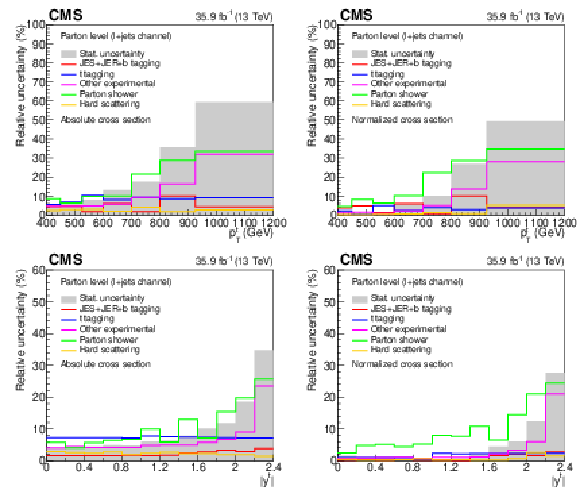
png pdf |
Figure 22:
Breakdown of the sources of systematic uncertainty affecting the differential cross section measurements in the $\ell $+jets channel at the parton level as a function of the top quark ${p_{\mathrm {T}}}$ (upper row) or $ {| y |}$ (lower row). Both the systematic uncertainties in the absolute (left column) and the normalized (right column) cross sections are shown. "JES+JER+b tagging" includes uncertainties due to the JES, JER, and small-$R$ jet b tagging efficiency; "t tagging" is the uncertainty associated with the large-$R$ jet t tagging efficiency; "Other experimental" includes the uncertainties originating from the background estimate, pileup modeling, lepton identification and trigger efficiency, and measurement of the integrated luminosity; "Parton shower" includes contributions from ISR and FSR, underlying event tune, ME-PS matching, and color reconnection; "Hard scattering" includes the uncertainty due to PDFs, as well as renormalization and factorization scales. |

png pdf |
Figure 22-a:
Breakdown of the sources of systematic uncertainty affecting the differential cross section measurements in the $\ell $+jets channel at the parton level as a function of the top quark ${p_{\mathrm {T}}}$. Systematic uncertainties in the absolute cross section is shown. "JES+JER+b tagging" includes uncertainties due to the JES, JER, and small-$R$ jet b tagging efficiency; "t tagging" is the uncertainty associated with the large-$R$ jet t tagging efficiency; "Other experimental" includes the uncertainties originating from the background estimate, pileup modeling, lepton identification and trigger efficiency, and measurement of the integrated luminosity; "Parton shower" includes contributions from ISR and FSR, underlying event tune, ME-PS matching, and color reconnection; "Hard scattering" includes the uncertainty due to PDFs, as well as renormalization and factorization scales. |
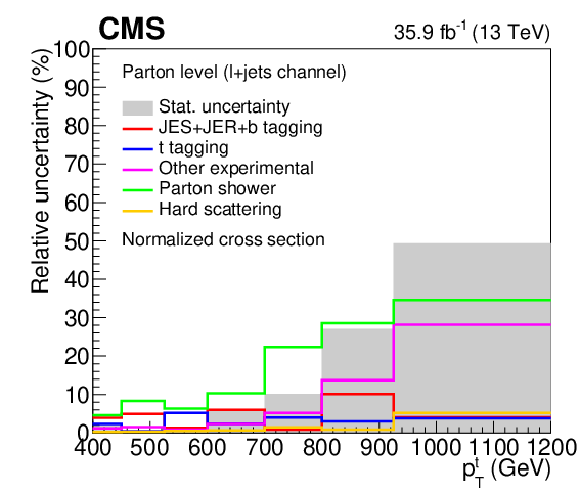
png pdf |
Figure 22-b:
Breakdown of the sources of systematic uncertainty affecting the differential cross section measurements in the $\ell $+jets channel at the parton level as a function of the top quark ${p_{\mathrm {T}}}$. Systematic uncertainties in the normalized cross section is shown. "JES+JER+b tagging" includes uncertainties due to the JES, JER, and small-$R$ jet b tagging efficiency; "t tagging" is the uncertainty associated with the large-$R$ jet t tagging efficiency; "Other experimental" includes the uncertainties originating from the background estimate, pileup modeling, lepton identification and trigger efficiency, and measurement of the integrated luminosity; "Parton shower" includes contributions from ISR and FSR, underlying event tune, ME-PS matching, and color reconnection; "Hard scattering" includes the uncertainty due to PDFs, as well as renormalization and factorization scales. |

png pdf |
Figure 22-c:
Breakdown of the sources of systematic uncertainty affecting the differential cross section measurements in the $\ell $+jets channel at the parton level as a function of the top quark $ {| y |}$. Systematic uncertainties in the absolute cross section is shown. "JES+JER+b tagging" includes uncertainties due to the JES, JER, and small-$R$ jet b tagging efficiency; "t tagging" is the uncertainty associated with the large-$R$ jet t tagging efficiency; "Other experimental" includes the uncertainties originating from the background estimate, pileup modeling, lepton identification and trigger efficiency, and measurement of the integrated luminosity; "Parton shower" includes contributions from ISR and FSR, underlying event tune, ME-PS matching, and color reconnection; "Hard scattering" includes the uncertainty due to PDFs, as well as renormalization and factorization scales. |
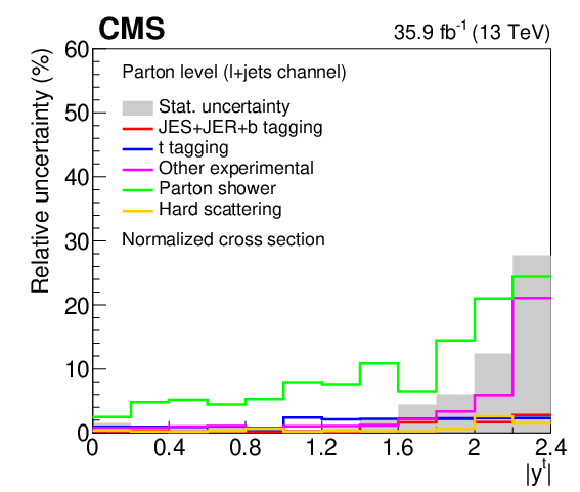
png pdf |
Figure 22-d:
Breakdown of the sources of systematic uncertainty affecting the differential cross section measurements in the $\ell $+jets channel at the parton level as a function of the top quark $ {| y |}$. Systematic uncertainties in the normalized cross section is shown. "JES+JER+b tagging" includes uncertainties due to the JES, JER, and small-$R$ jet b tagging efficiency; "t tagging" is the uncertainty associated with the large-$R$ jet t tagging efficiency; "Other experimental" includes the uncertainties originating from the background estimate, pileup modeling, lepton identification and trigger efficiency, and measurement of the integrated luminosity; "Parton shower" includes contributions from ISR and FSR, underlying event tune, ME-PS matching, and color reconnection; "Hard scattering" includes the uncertainty due to PDFs, as well as renormalization and factorization scales. |
| Tables | |

png pdf |
Table 1:
Fitted values of the nuisance parameters for the fit to data in the SR$_{\mathrm {A}}$ in the all-jet channel. |

png pdf |
Table 2:
Observed and predicted event yields with their respective statistical uncertainties in the signal region SR for the all-jet channel. The ${\mathrm{t} {}\mathrm{\bar{t}}}$ and multijet yields are obtained from the fit in SR$_{\mathrm {A}}$. |
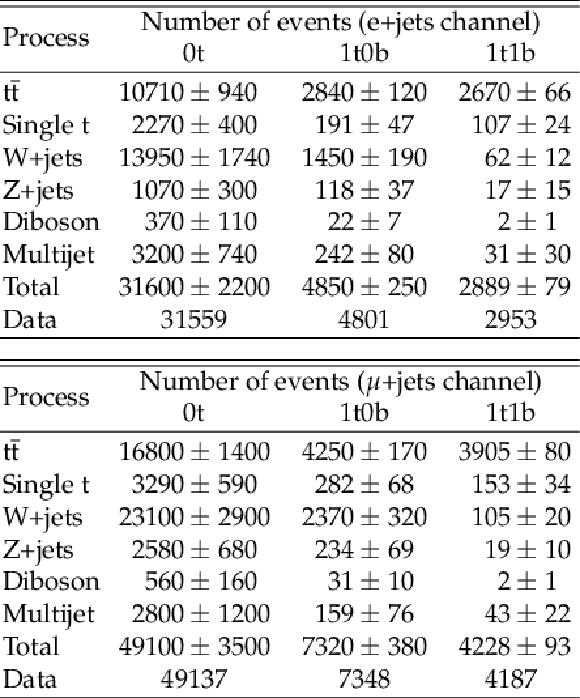
png pdf |
Table 3:
Posterior signal and background event yields in the 0t, 1t0b, and 1t1b categories, together with the observed yields in data. The uncertainties include all posterior experimental contributions. |
| Summary |
| A measurement was presented of the top quark pair ($\mathrm{t\bar{t}}$) cross section for top quarks with high transverse momentum (${p_{\mathrm{T}}}$) produced in pp collisions at 13 TeV. The measurement uses events in which either one or both top quarks decay to jets, and where the decay products cannot be resolved but are instead clustered in a single large-radius ($R$) jet with ${p_{\mathrm{T}}} > $ 400 GeV. The all-jet final state contains two such large-$R$ jets, while the lepton+jets final state is identified through the presence of an electron or muon, a b-tagged jet, missing transverse momentum from the escaping neutrino, and a single t-tagged, large-$R$ jet. The measurement utilizes a larger data set relative to previous results to explore a wider phase space of $\mathrm{t\bar{t}}$ production and to elucidate any discrepancies with theory that were reported in previous publications. For the all-jet channel, absolute and normalized differential cross sections are measured as functions of the leading and subleading top quark ${p_{\mathrm{T}}}$ and absolute rapidity $|y|$, and as a function of the invariant mass, ${p_{\mathrm{T}}}$, and $y$ of the $\mathrm{t\bar{t}}$ system, unfolded to the particle level within a fiducial phase space and to the parton level. For the lepton+jets channel, the differential cross sections are measured as functions of the ${p_{\mathrm{T}}}$ and $|y|$ of the top quark that decays according to $\mathrm{t} \to \mathrm{W} \mathrm{b} \to \mathrm{q} \mathrm{\bar{q}}' \mathrm{b}$, both at the particle and parton levels. The results are compared with theory using the POWHEG matrix element generator, interfaced to either PYTHIA or HERWIG++ for the underlying event and parton showering, and with the MadGraph5+MCatNLO matrix element generator, interfaced to PYTHIA. All the models significantly exceed the absolute cross section in the phase spaces of the measurements. However, the normalized differential cross sections are consistently well described. The most notable discrepancies are observed in the invariant mass of the $\mathrm{t\bar{t}}$ system and the subleading top quark ${p_{\mathrm{T}}}$ in the all-jet channel, where theory predicts a higher cross section at high mass and at high ${p_{\mathrm{T}}}$, respectively. To further investigate the severity of this discrepancy, more data are needed to enhance the statistical significance of the measurement in this region of phase space. |
| References | ||||
| 1 | ATLAS Collaboration | Measurements of top-quark pair single- and double-differential cross-sections in the all-hadronic channel in $ pp $ collisions at $ \sqrt{s}=13 \mbox{TeV} $ using the ATLAS detector | Submitted to JHEP | 2006.09274 |
| 2 | ATLAS Collaboration | Measurements of top-quark pair differential and double-differential cross-sections in the $ \ell $+jets channel with $ pp $ collisions at $ \sqrt{s}= $ 13 TeV using the ATLAS detector | EPJC 79 (2019) 1028 | 1908.07305 |
| 3 | ATLAS Collaboration | Measurement of the $ t\bar{t} $ production cross-section and lepton differential distributions in $ e\mu $ dilepton events from $ pp $ collisions at $ \sqrt{s}= $ 13 TeV with the ATLAS detector | EPJC 80 (2020) 528 | 1910.08819 |
| 4 | ATLAS Collaboration | Measurements of top-quark pair differential cross-sections in the lepton+jets channel in $ pp $ collisions at $ \sqrt{s}= $ 13 TeV using the ATLAS detector | JHEP 11 (2017) 191 | 1708.00727 |
| 5 | ATLAS Collaboration | Measurements of top-quark pair differential cross-sections in the $ e\mu $ channel in $ pp $ collisions at $ \sqrt{s} = $ 13 TeV using the ATLAS detector | EPJC 77 (2017) 292 | 1612.05220 |
| 6 | ATLAS Collaboration | Measurement of lepton differential distributions and the top quark mass in $ t\bar{t} $ production in $ pp $ collisions at $ \sqrt{s}= $ 8 TeV with the ATLAS detector | EPJC 77 (2017) 804 | 1709.09407 |
| 7 | ATLAS Collaboration | Measurement of top quark pair differential cross-sections in the dilepton channel in $ pp $ collisions at $ \sqrt{s} = $ 7 and 8 TeV with ATLAS | PRD 94 (2016) 092003 | 1607.07281 |
| 8 | ATLAS Collaboration | Differential top-antitop cross-section measurements as a function of observables constructed from final-state particles using pp collisions at $ \sqrt{s}= $ 7 TeV in the ATLAS detector | JHEP 06 (2015) 100 | 1502.05923 |
| 9 | ATLAS Collaboration | Measurements of top quark pair relative differential cross-sections with ATLAS in $ pp $ collisions at $ \sqrt{s}= $ 7 TeV | EPJC 73 (2013) 2261 | 1207.5644 |
| 10 | CMS Collaboration | Measurement of normalized differential $ \mathrm{t}\overline{\mathrm{t}} $ cross sections in the dilepton channel from pp collisions at $ \sqrt{s}= $ 13 TeV | JHEP 04 (2018) 060 | CMS-TOP-16-007 1708.07638 |
| 11 | CMS Collaboration | Measurements of normalised multi-differential cross sections for top quark pair production in pp collisions at $ \sqrt{s}= $ 13 TeV and simultaneous determination of the strong coupling strength, top quark pole mass and parton distribution functions | Submitted to EPJC---in proof | CMS-TOP-18-004 1904.05237 |
| 12 | CMS Collaboration | Measurements of $ \mathrm{t\overline{t}} $ differential cross sections in proton-proton collisions at $ \sqrt{s}= $ 13 TeV using events containing two leptons | JHEP 02 (2019) 149 | CMS-TOP-17-014 1811.06625 |
| 13 | CMS Collaboration | Measurement of differential cross sections for top quark pair production using the lepton+jets final state in proton-proton collisions at 13 TeV | PRD 95 (2017) 092001 | CMS-TOP-16-008 1610.04191 |
| 14 | CMS Collaboration | Measurements of differential cross sections of top quark pair production as a function of kinematic event variables in proton-proton collisions at $ \sqrt{s}= $ 13 TeV | JHEP 06 (2018) 002 | CMS-TOP-16-014 1803.03991 |
| 15 | CMS Collaboration | Measurement of double-differential cross sections for top quark pair production in pp collisions at $ \sqrt{s} = $ 8 TeV and impact on parton distribution functions | EPJC 77 (2017) 459 | CMS-TOP-14-013 1703.01630 |
| 16 | CMS Collaboration | Measurement of the differential cross section for top quark pair production in pp collisions at $ \sqrt{s} = $ 8 TeV | EPJC 75 (2015) 542 | CMS-TOP-12-028 1505.04480 |
| 17 | CMS Collaboration | Measurement of the differential cross sections for top quark pair production as a function of kinematic event variables in pp collisions at $ \sqrt{s} = $ 7 and 8 TeV | PRD 94 (2016) 052006 | CMS-TOP-12-042 1607.00837 |
| 18 | CMS Collaboration | Measurement of differential top-quark pair production cross sections in pp collisions at $ \sqrt{s}= $ 7 TeV | EPJC 73 (2013) 2339 | CMS-TOP-11-013 1211.2220 |
| 19 | CMS Collaboration | Measurement of differential cross sections for the production of top quark pairs and of additional jets in lepton+jets events from pp collisions at $ \sqrt{s} = $ 13 TeV | PRD 97 (2018) 112003 | CMS-TOP-17-002 1803.08856 |
| 20 | ATLAS Collaboration | Measurements of $ t\bar{t} $ differential cross-sections of highly boosted top quarks decaying to all-hadronic final states in $ pp $ collisions at $ \sqrt{s}= $ 13 TeV using the ATLAS detector | PRD 98 (2018) 012003 | 1801.02052 |
| 21 | ATLAS Collaboration | Measurement of the differential cross-section of highly boosted top quarks as a function of their transverse momentum in $ \sqrt{s} = $ 8 TeV proton-proton collisions using the ATLAS detector | PRD 93 (2016) 032009 | 1510.03818 |
| 22 | CMS Collaboration | Measurement of the integrated and differential $ \mathrm{t\bar{t}} $ production cross sections for high-$ {p_{\mathrm{T}}} $ top quarks in pp collisions at $ \sqrt s = $ 8 TeV | PRD 94 (2016) 072002 | CMS-TOP-14-012 1605.00116 |
| 23 | CMS Collaboration | The CMS experiment at the CERN LHC | JINST 3 (2008) S08004 | CMS-00-001 |
| 24 | CMS Collaboration | The CMS trigger system | JINST 12 (2017) P01020 | CMS-TRG-12-001 1609.02366 |
| 25 | P. Nason | A new method for combining NLO QCD with shower Monte Carlo algorithms | JHEP 11 (2004) 040 | hep-ph/0409146 |
| 26 | S. Frixione, P. Nason, and G. Ridolfi | A positive-weight next-to-leading-order Monte Carlo for heavy flavour hadroproduction | JHEP 09 (2007) 126 | 0707.3088 |
| 27 | S. Frixione, P. Nason, and C. Oleari | Matching NLO QCD computations with parton shower simulations: the POWHEG method | JHEP 11 (2007) 070 | 0709.2092 |
| 28 | S. Alioli, P. Nason, C. Oleari, and E. Re | A general framework for implementing NLO calculations in shower Monte Carlo programs: the POWHEG BOX | JHEP 06 (2010) 043 | 1002.2581 |
| 29 | S. Alioli, S. O. Moch, and P. Uwer | Hadronic top-quark pair-production with one jet and parton showering | JHEP 01 (2012) 137 | 1110.5251 |
| 30 | S. Alioli, P. Nason, C. Oleari, and E. Re | NLO single-top production matched with shower in POWHEG: $ s $- and $ t $-channel contributions | JHEP 09 (2009) 111 | 0907.4076 |
| 31 | J. Alwall et al. | The automated computation of tree-level and next-to-leading order differential cross sections, and their matching to parton shower simulations | JHEP 07 (2014) 079 | 1405.0301 |
| 32 | J. Alwall et al. | Comparative study of various algorithms for the merging of parton showers and matrix elements in hadronic collisions | EPJC 53 (2008) 473 | 0706.2569 |
| 33 | T. Sjostrand, S. Mrenna, and P. Z. Skands | PYTHIA 6.4 physics and manual | JHEP 05 (2006) 026 | hep-ph/0603175 |
| 34 | T. Sjostrand, S. Mrenna, and P. Z. Skands | A brief introduction to PYTHIA 8.1 | CPC 178 (2008) 852 | 0710.3820 |
| 35 | NNPDF Collaboration | Parton distributions for the LHC Run II | JHEP 04 (2015) 040 | 1410.8849 |
| 36 | CMS Collaboration | Event generator tunes obtained from underlying event and multiparton scattering measurements | EPJC 76 (2015) 155 | CMS-GEN-14-001 1512.00815 |
| 37 | CMS Collaboration | Investigations of the impact of the parton shower tuning in Pythia8 in the modelling of $ \mathrm{t\overline{t}} $ at $ \sqrt{s}= $ 8 and 13 TeV | CMS-PAS-TOP-16-021 | CMS-PAS-TOP-16-021 |
| 38 | GEANT4 Collaboration | GEANT4 --- a simulation toolkit | NIMA 506 (2003) 250 | |
| 39 | M. Czakon and A. Mitov | Top++: A program for the calculation of the top-pair cross-section at hadron colliders | CPC 185 (2014) 2930 | 1112.5675 |
| 40 | Y. Li and F. Petriello | Combining QCD and electroweak corrections to dilepton production in the framework of the FEWZ simulation code | PRD 86 (2012) 094034 | 1208.5967 |
| 41 | N. Kidonakis | Top Quark Production | 1311.0283 | |
| 42 | M. Bahr et al. | Herwig++ Physics and Manual | EPJC 58 (2008) 639 | 0803.0883 |
| 43 | S. Gieseke, C. Rohr, and A. Siodmok | Colour reconnections in Herwig++ | EPJC 72 (2012) 2225 | 1206.0041 |
| 44 | CMS Collaboration | Particle-flow reconstruction and global event description with the cms detector | JINST 12 (2017) P10003 | CMS-PRF-14-001 1706.04965 |
| 45 | M. Cacciari, G. P. Salam, and G. Soyez | The anti-$ k_{\text{T}} $ jet clustering algorithm | JHEP 04 (2008) 063 | 0802.1189 |
| 46 | M. Cacciari, G. P. Salam, and G. Soyez | FastJet user manual | EPJC 72 (2012) 1896 | 1111.6097 |
| 47 | K. Rehermann and B. Tweedie | Efficient identification of boosted semileptonic top quarks at the LHC | JHEP 03 (2011) 059 | 1007.2221 |
| 48 | CMS Collaboration | Measurements of inclusive W and Z cross sections in pp collisions at $ \sqrt {s} = $ 7 TeV | JHEP 01 (2011) 080 | CMS-EWK-10-005 1107.4789 |
| 49 | M. Cacciari and G. P. Salam | Pileup subtraction using jet areas | PLB 659 (2008) 119 | 0707.1378 |
| 50 | CMS Collaboration | Jet energy scale and resolution in the CMS experiment in pp collisions at 8 TeV | JINST 12 (2017) P02014 | CMS-JME-13-004 1607.03663 |
| 51 | CMS Collaboration | Jet algorithms performance in 13 TeV data | CMS-PAS-JME-16-003 | CMS-PAS-JME-16-003 |
| 52 | M. Dasgupta, A. Fregoso, S. Marzani, and G. P. Salam | Towards an understanding of jet substructure | JHEP 09 (2013) 029 | 1307.0007 |
| 53 | J. M. Butterworth, A. R. Davison, M. Rubin, and G. P. Salam | Jet substructure as a new Higgs search channel at the LHC | PRL 100 (2008) 242001 | 0802.2470 |
| 54 | A. J. Larkoski, S. Marzani, G. Soyez, and J. Thaler | Soft drop | JHEP 05 (2014) 146 | 1402.2657 |
| 55 | Y. L. Dokshitzer, G. D. Leder, S. Moretti, and B. R. Webber | Better jet clustering algorithms | JHEP 08 (1997) 001 | hep-ph/9707323 |
| 56 | M. Wobisch and T. Wengler | Hadronization corrections to jet cross-sections in deep inelastic scattering | in Proceedings of the Workshop on Monte Carlo Generators for HERA Physics, Hamburg, Germany, p. 270 1998 | hep-ph/9907280 |
| 57 | J. Thaler and K. Van Tilburg | Identifying boosted objects with $ N $-subjettiness | JHEP 03 (2011) 015 | 1011.2268 |
| 58 | CMS Collaboration | Identification of heavy, energetic, hadronically decaying particles using machine-learning techniques | JINST 15 (2020) P06005 | CMS-JME-18-002 2004.08262 |
| 59 | S. Catani, Y. L. Dokshitzer, M. H. Seymour, and B. R. Webber | Longitudinally invariant $ k_{\text{T}} $ clustering algorithms for hadron-hadron collisions | NPB 406 (1993) 187 | |
| 60 | J. Thaler and K. Van Tilburg | Maximizing boosted top identification by minimizing $ N $-subjettiness | JHEP 02 (2012) 093 | 1108.2701 |
| 61 | CMS Collaboration | Identification of heavy-flavour jets with the CMS detector in pp collisions at 13 TeV | JINST 13 (2018) P05011 | CMS-BTV-16-002 1712.07158 |
| 62 | H. Voss, A. Hocker, J. Stelzer, and F. Tegenfeldt | TMVA, the toolkit for multivariate data analysis with ROOT | in XIth International Workshop on Advanced Computing and Analysis Techniques in Physics Research (ACAT), p. 40 2007 [PoS(ACAT)040] | physics/0703039 |
| 63 | W. Verkerke and D. P. Kirkby | The RooFit toolkit for data modeling | in Proceedings of the 13th International Conference for Computing in High-Energy and Nuclear Physics (CHEP03) 2003 [eConf C0303241, MOLT007] | physics/0306116 |
| 64 | ATLAS Collaboration | Measurement of the inelastic proton-proton cross section at $ \sqrt{s} = $ 13 TeV with the ATLAS detector at the LHC | PRL 117 (2016) 182002 | 1606.02625 |
| 65 | CMS Collaboration | CMS luminosity measurements for the 2016 data taking period | CMS-PAS-LUM-17-001 | CMS-PAS-LUM-17-001 |
| 66 | P. Skands, S. Carrazza, and J. Rojo | Tuning PYTHIA 8.1: the Monash 2013 tune | EPJC 74 (2014) 3024 | 1404.5630 |
| 67 | S. Schmitt | TUnfold: an algorithm for correcting migration effects in high energy physics | JINST 7 (2012) T10003 | 1205.6201 |

|
Compact Muon Solenoid LHC, CERN |

|

|

|

|

|

|